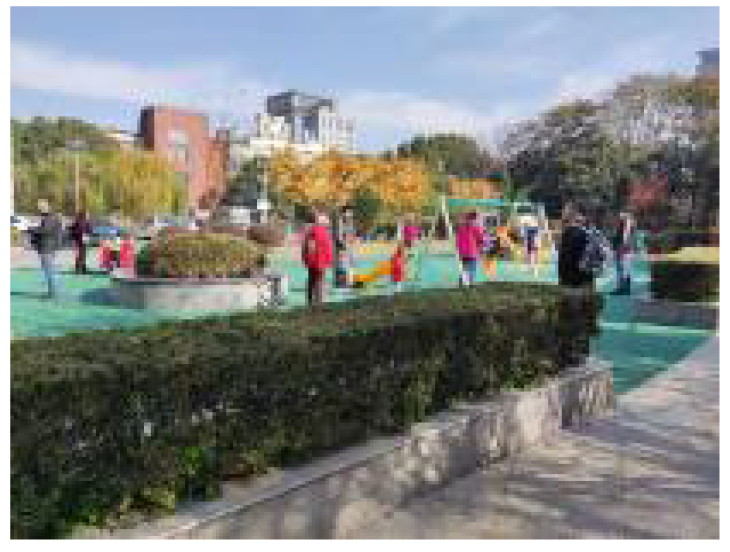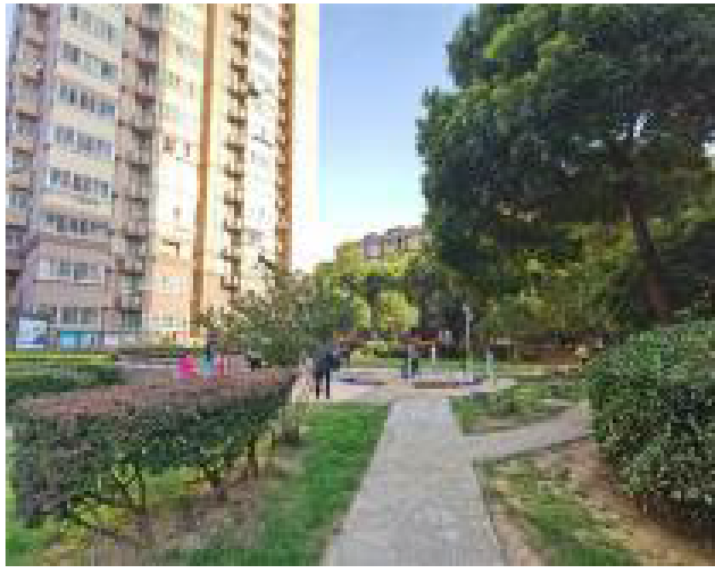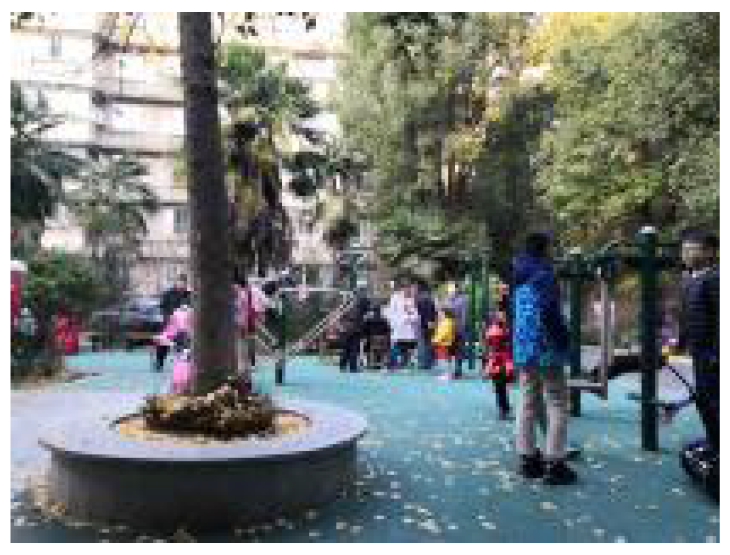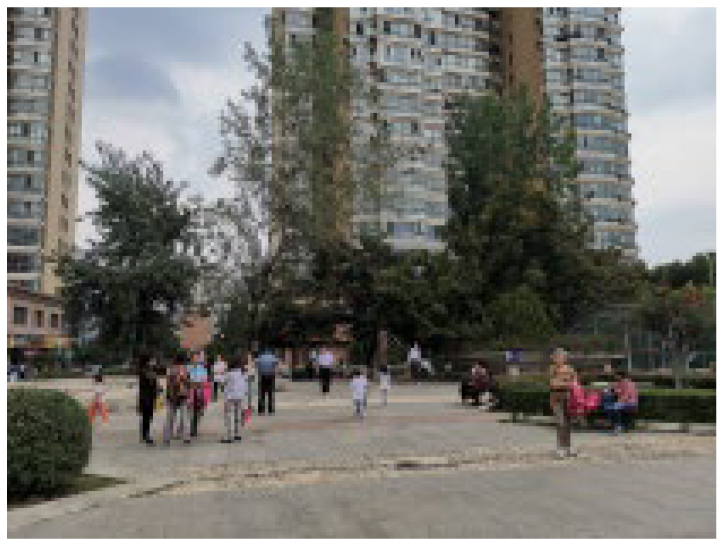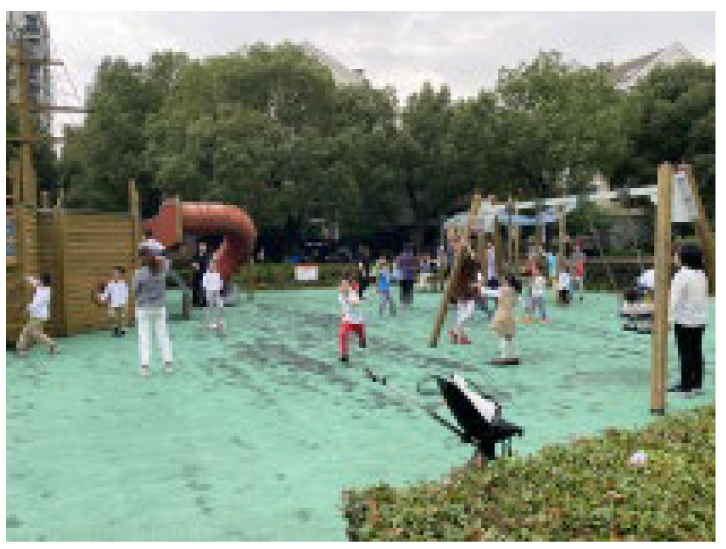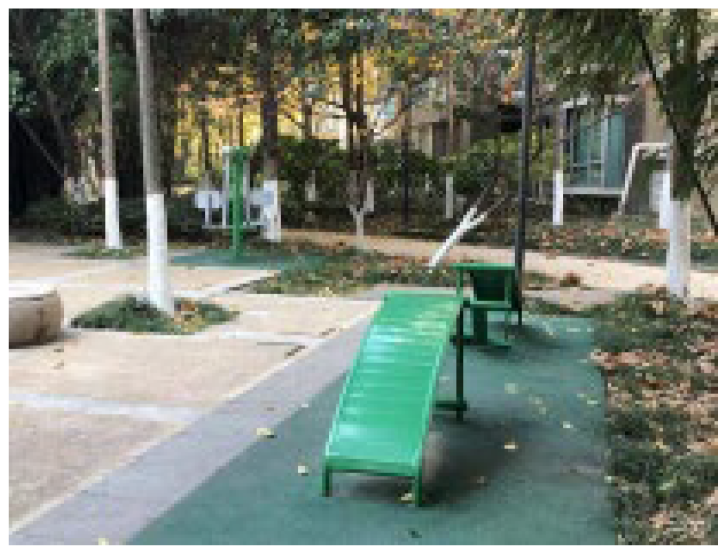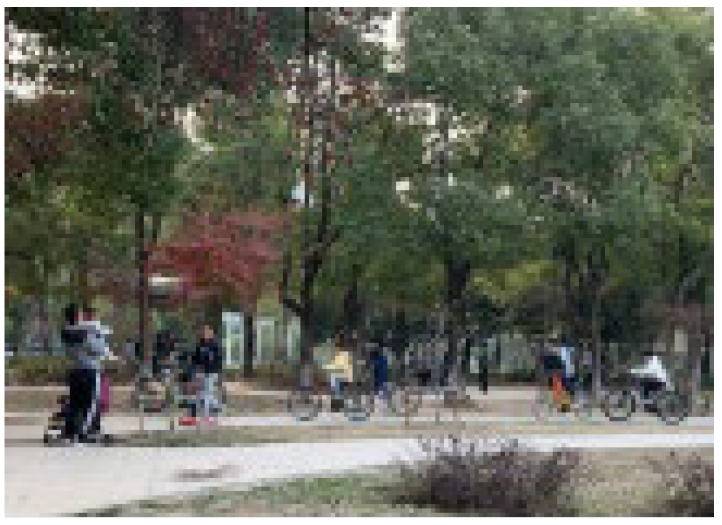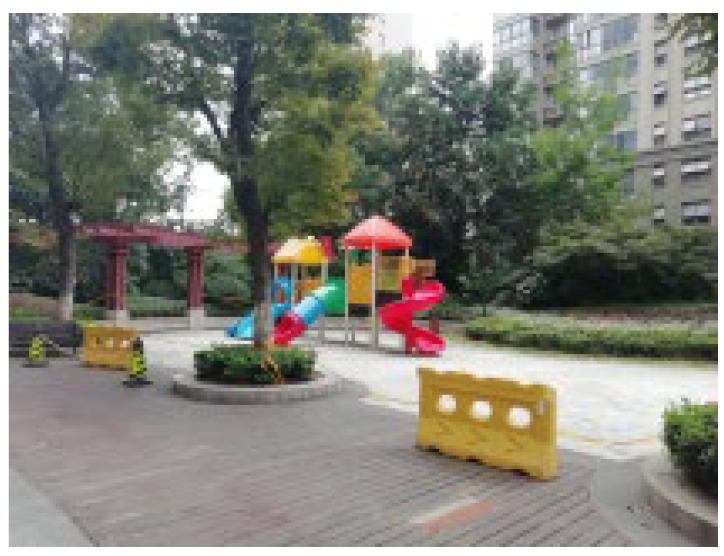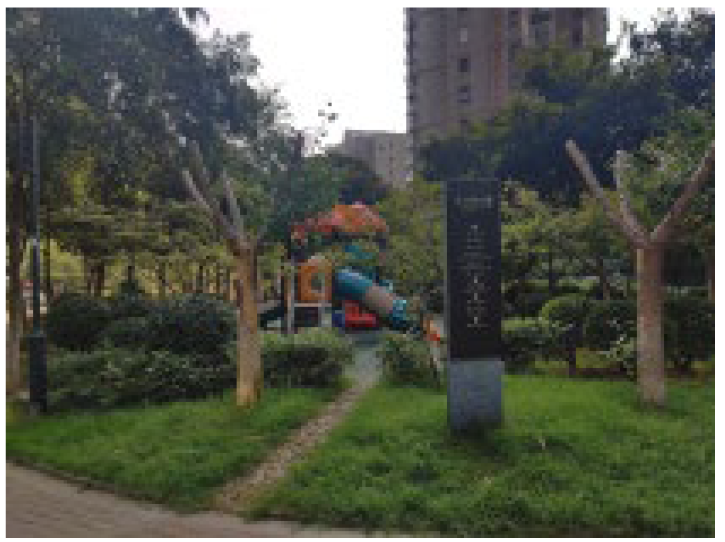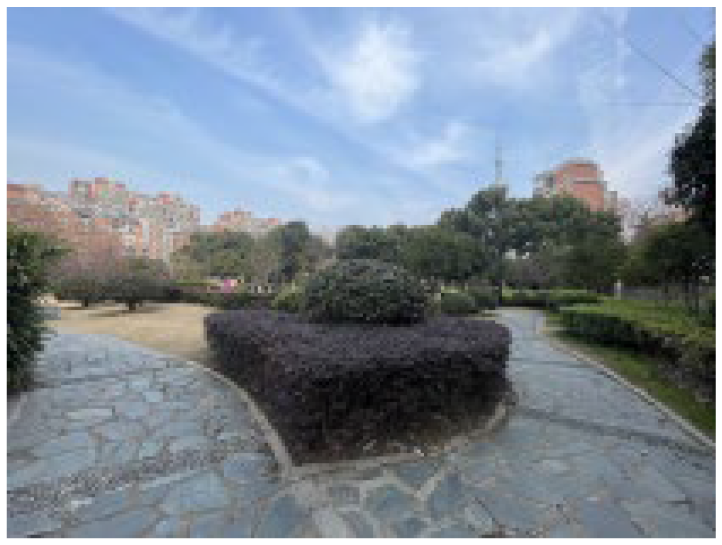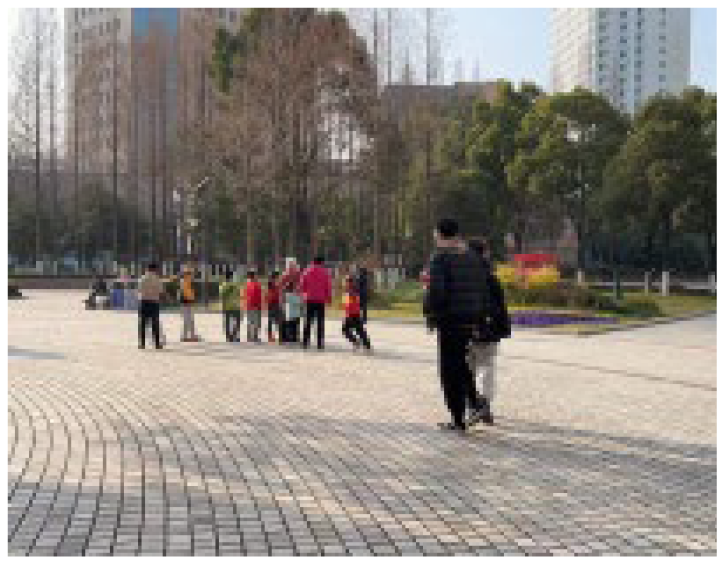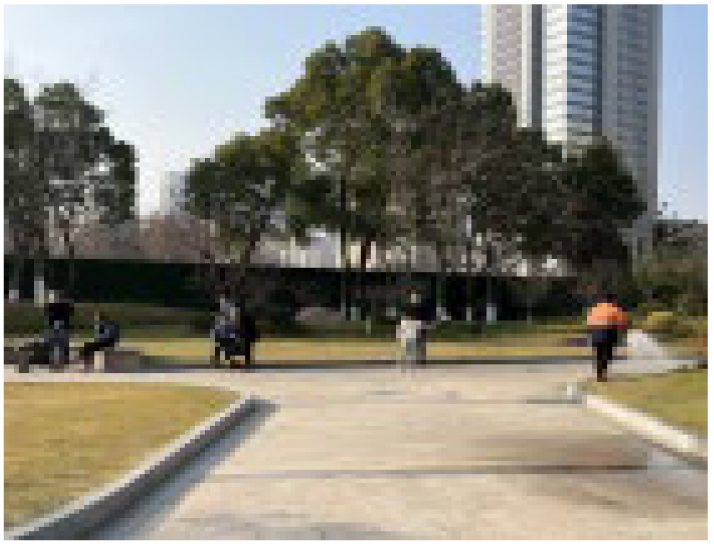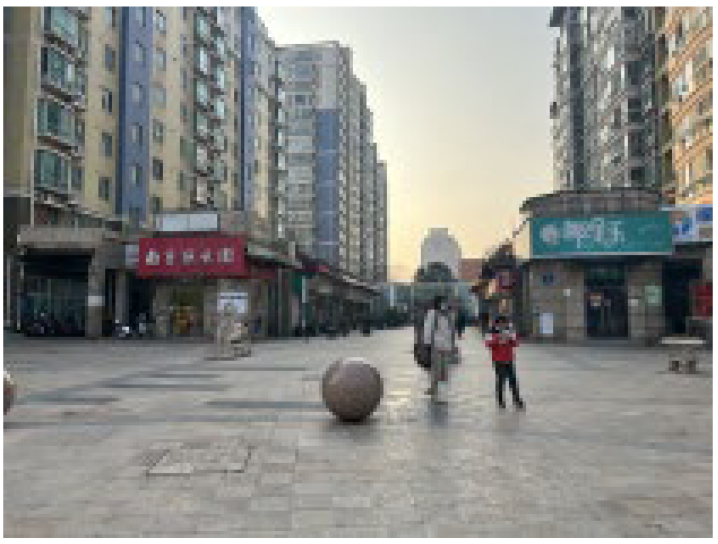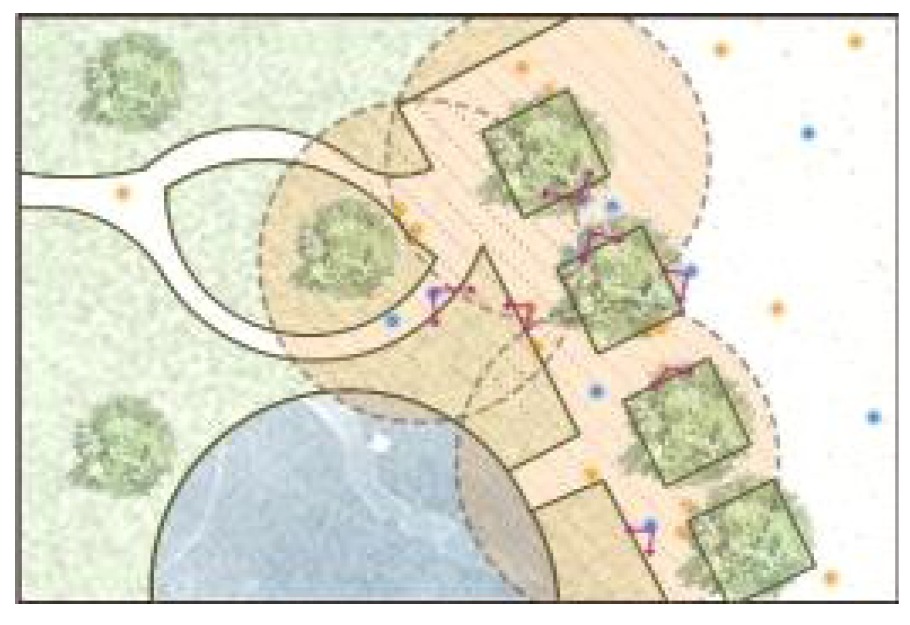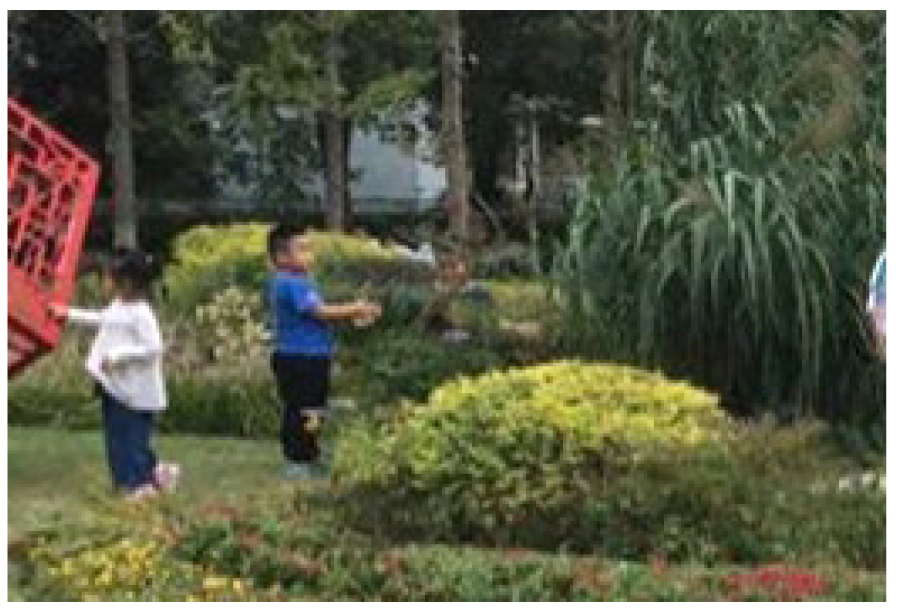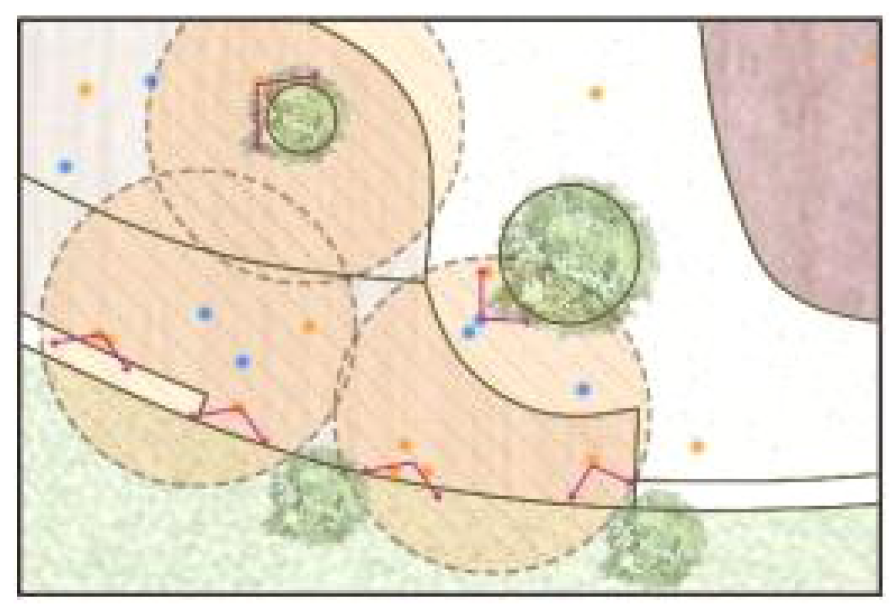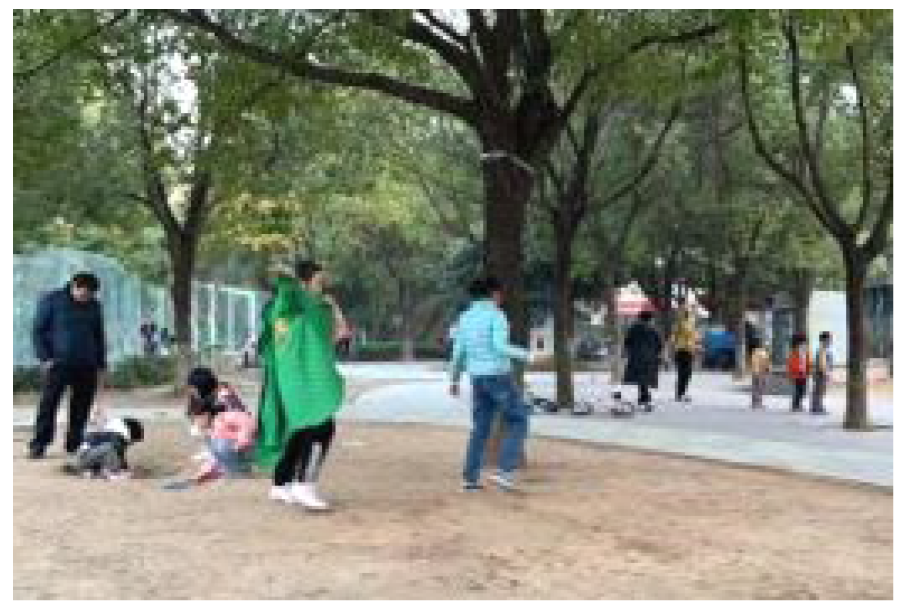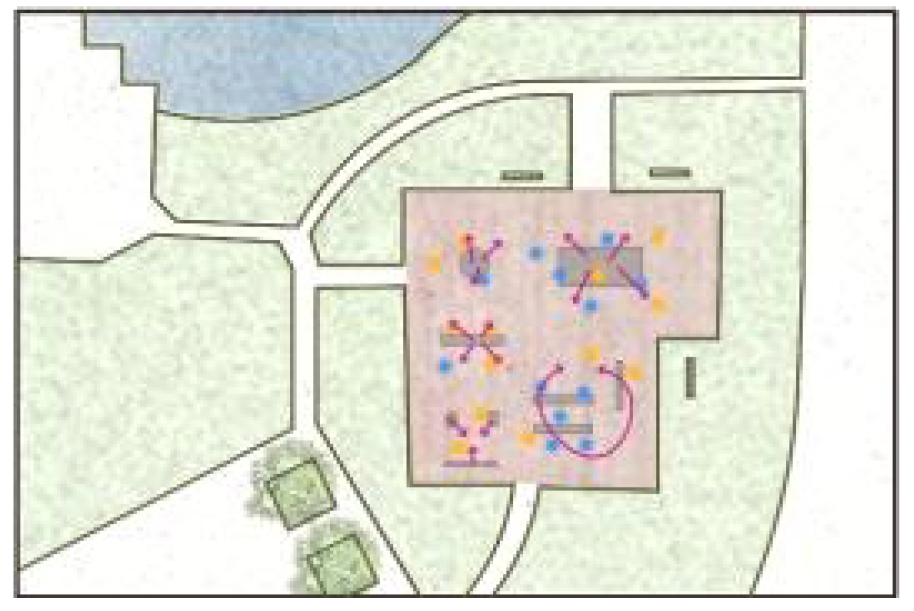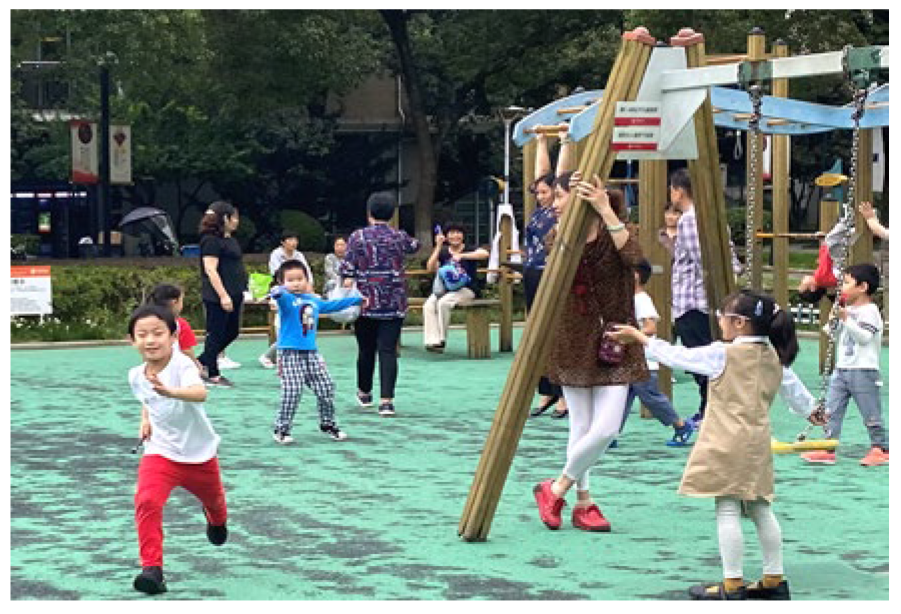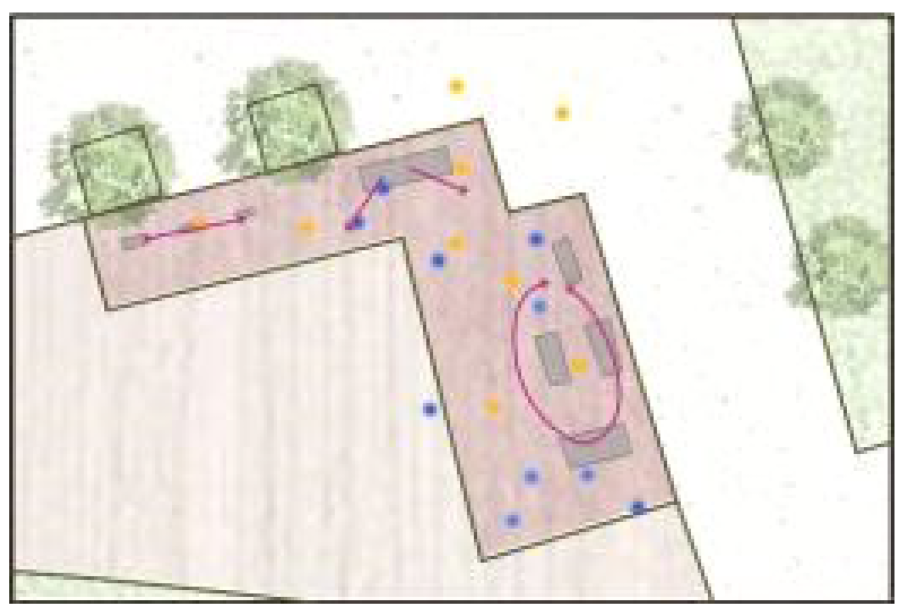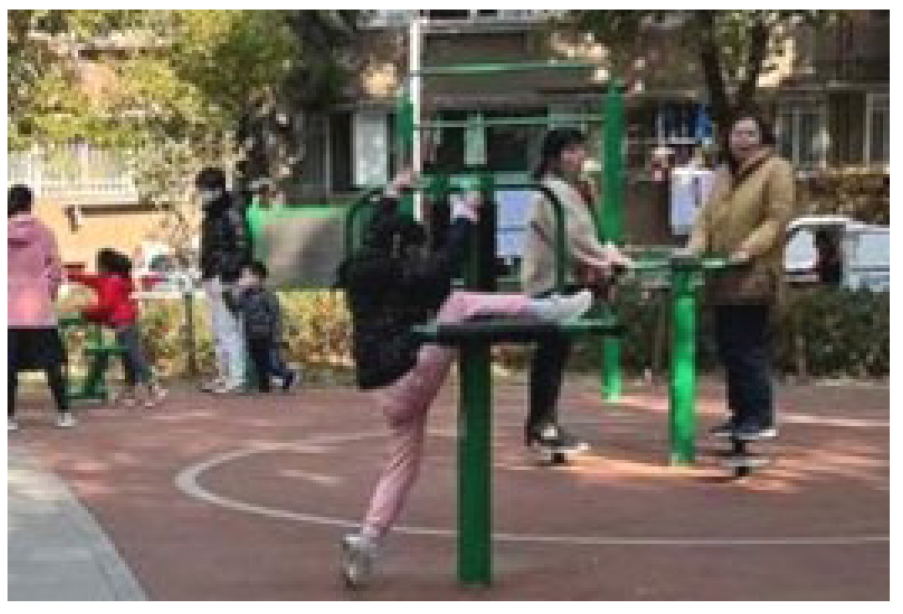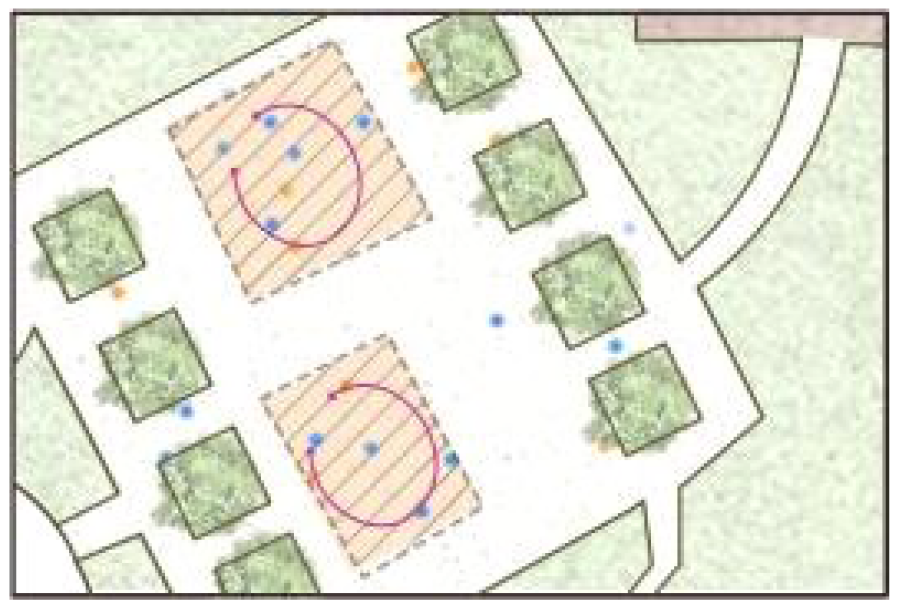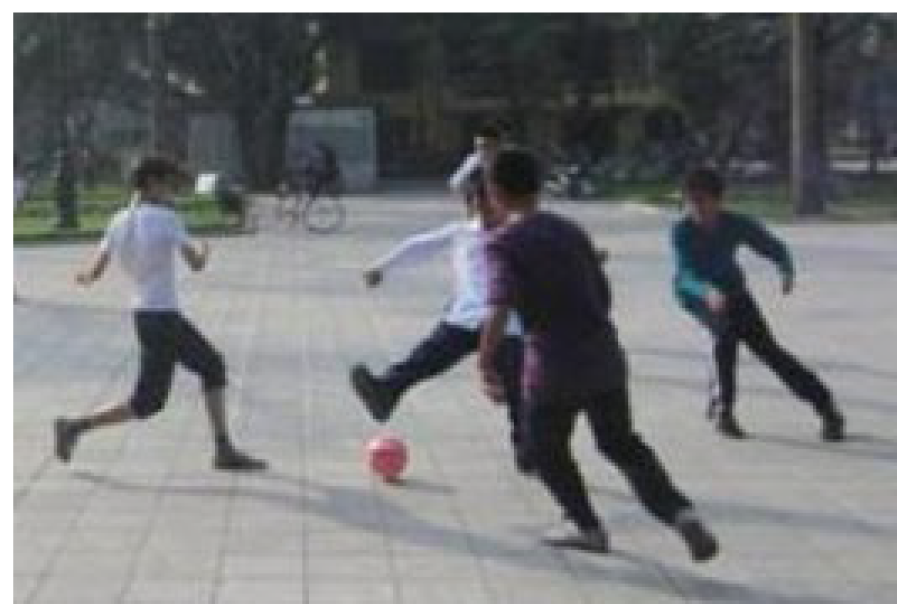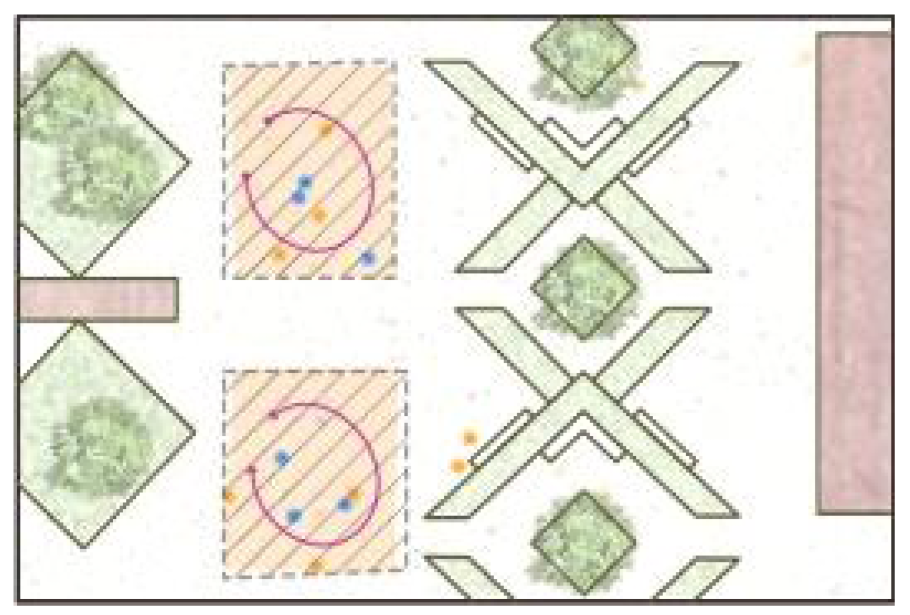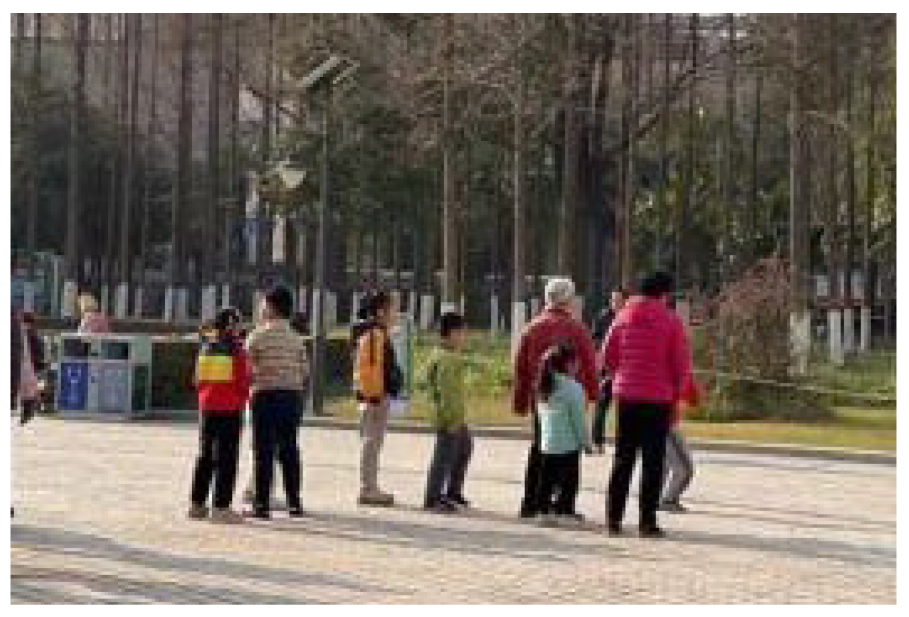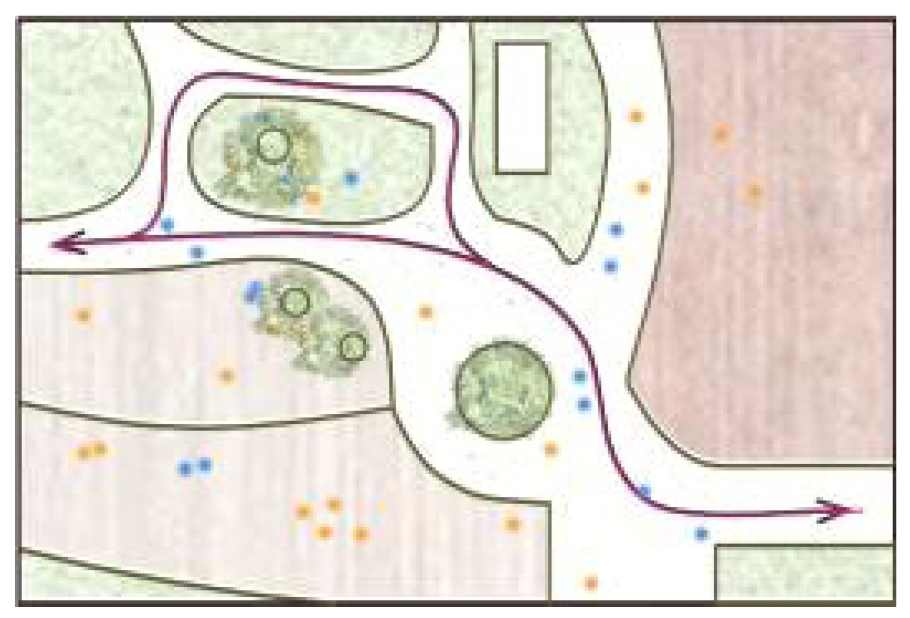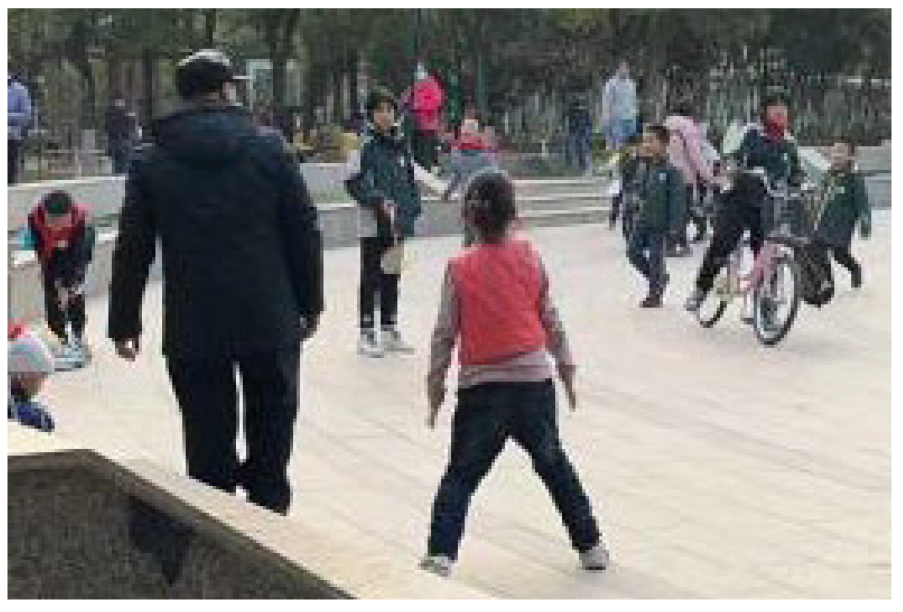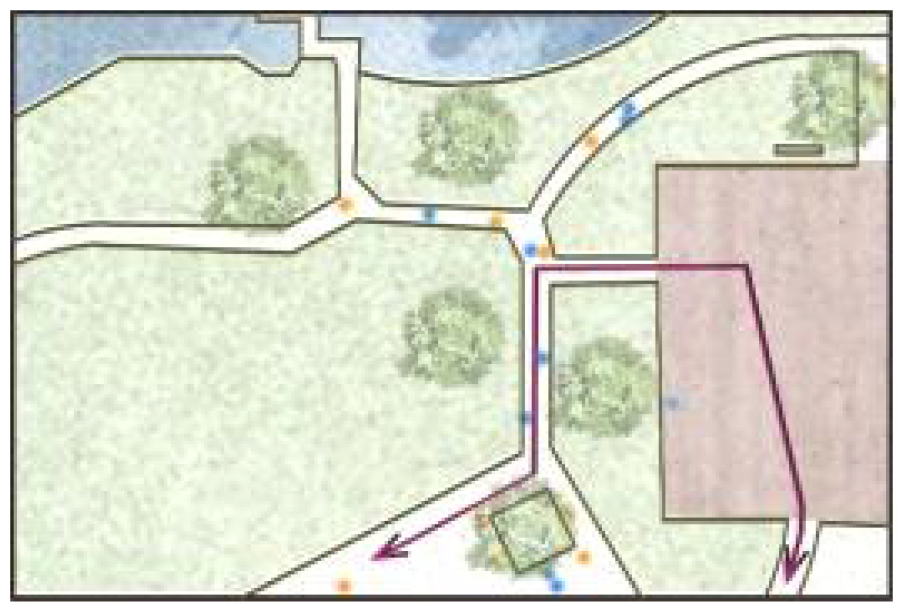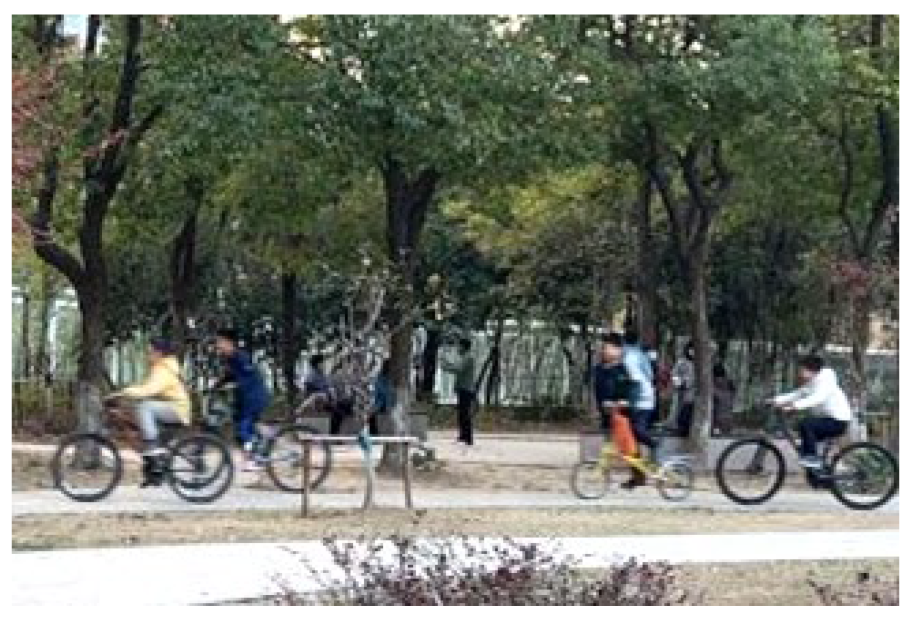Abstract
Children are a vulnerable population that is frequently overlooked in urban planning. The spatial demands of children are garnering broader consideration in the development of public spaces in cities as efforts to promote child-friendly cities. Children’s independent activities (CIAs) during childhood are undeniably beneficial to their physical and mental health. Residential areas are the main places for children’s daily activities. Building a suitable outdoor activity space in the community for children’s recreation is an essential foundation for improving CIAs and promoting the development of child-friendly neighborhoods. A sample of 15 typical children’s outdoor activity spaces in residential neighborhoods of Nanjing, China, was selected for the study to observe and record CIAs. The built environment indicators of residential outdoor spaces were extracted, and correlation analysis was employed to investigate the residential outdoor space elements relevant to CIAs. The results indicated that at the site level, higher percentages of tree coverage and soft paving enhanced CIAs, while high functional mix inhibited them. Additionally, gated communities, top-notch sanitation, secure facilities, neighborhoods with higher residential densities, and a diversity of activity facilities all stimulated children to engage in independent activities. Furthermore, questionnaires for the guardian indicated that they placed a high priority on site safety, and that waterfront areas and activity sites where incidents had occurred decreased parents’ willingness to allow participation in CIAs, whereas safety education or the use of positioning devices may promote CIAs. Based on the above results, we proposed appropriate adaptations for places in residential neighborhoods. The study expects to create a higher quality environment in residential neighborhoods for children to play in public spaces and provide beneficial help to improve the child-friendly neighborhood.
1. Introduction
Children’s independent activities (CIAs), defined as the freedom to play around their own neighborhood independently or with their peers without adult supervision, are a genuine representation of children’s mobility [1]. It is also a fundamental approach for children to learn about the urban environment as they grow [2]. The signing of Convention on the Rights of the Child in 1990 brought widespread attention to children’s issues. In 1996, UNICEF and UN-Habitat formally launched the Child Friendly Cities Initiatives at the second United Nations Conference on Human Settlements (Habitat II) to create a system of urban governance that would hear the voices of children and fulfill their needs, priorities and rights [3]. Since then, a series of international declarations have been signed and a special committee has been established for children’s rights. Although there have been ongoing improvements to the child welfare and children’s rights systems, fewer substantive changes have occurred in the status of children’s rights.
With the development of urbanization, urban motorized traffic steadily encroaches on traditional street areas, and urban development initiatives shrink children’s outdoor space. The proportion and the spectrum of CIAs have become an irreversible fact. In China, the situation is perhaps even less optimistic. According to data from China’s seventh national census, there are approximately 250 million children under the age of 14, accounting for 17.95% of the country’s total population, and the number of children has also increased over the last decade. However, there is a dearth of variety and a small number of public outdoor areas in cities that are appropriate for children’s activities. The amount of time children spend outside is drastically reduced, and their rights and interests of space are gradually taken away. According to the Assessment Report on China’s Children and Youth Physical Fitness Index (2017), the evaluation score for children’s physical activity level is just 11.4 out of 100. The trend of motorization of children’s travel, indoor and static activities has triggered problems such as childhood obesity, impaired concentration, and mood swings, all of which have seriously affected children’s physical and mental health. Complicated reasons have conspired to bring forth these circumstances. Parents’ concern about the potential risks of children’s activity space, the unfriendly travel environment for children, the alteration of recreational activities due to the rapid development of electronic media, and the increasing pressure of schoolwork, all exert a negative influence on CIAs as well as their physical and mental health.
The role of CIAs in promoting healthy development has been demonstrated in many studies. Comparative studies have revealed that independent children tend to be more active and more physically active than those accompanied by parents [4,5]. In addition to encouraging children to become more physically active, independent activities are also good for their psychological and social growth. Children can develop self-awareness of autonomous activities, risk assessment insight, spatial awareness, wayfinding skills, and the ability to make decisions on their own, for example [6,7]. It allows children to cultivate exploration capabilities, communication skills, and environmental adaptability, as well as self-confidence, courage, seriousness, patience, a sense of responsibility, and a mindset of not being afraid of challenges [8].
The Chinese government has also paid attention to the issue, launching a series of guiding documents and including the construction of child-friendly cities as a pivotal point in the 14th Five-Year Plan to ensure children’s rights and spatial interests in the city and promote their independent activities. Nevertheless, most of the current research on CIAs in China focuses on street space and commuting space at the urban scale, while less on the residential level. As the primary space for CIAs, the quality of the spatial environment in urban residential areas has a decisive influence on children’s independent activities. Hence, the appropriate construction of outdoor spaces in residential areas is of critical significance to improve CIAs and promote children’s physical and mental health.
2. Literature Review
Methods such as questionnaires, interviews, children’s travel diaries, children’s cognitive maps, behavioral mapping, and GPS tracking methods are widely used in the study of permission for CIAs or the characteristics of CIAs [9,10,11,12,13,14,15]. Analysis and evaluation methods such as chi-square tests, regression analysis, principal component analysis, and the PRISMA system are frequently chosen by researchers in various countries [16,17,18,19,20,21]. Research has found that CIAs have declined significantly over the last 20 years, which has sparked extensive discussions in the fields of health, sociology, psychology, and geography [22,23,24,25,26,27]. Specifically, the intensity of children’s physical activity and factors influencing childhood obesity, children’s perceptions of the community and its safety, parental social attributes, social supervision and policy management were addressed.
The physical environment could be further split into the community environment, school environment, landscape environment, and traffic environment, and the study mainly focused on the impact of the commuting environment, traffic issues, walkability, infrastructure, and other related factors. A higher level of physical activity was found to be associated with accessibility and availability adjacent to greenspace, parklands, recreational areas, and sidewalks [28,29]. Research on the correlation between building density, walkability, traffic conditions, and CIAs in the community found that increased motorized traffic led to a reduction in CIAs [30,31,32,33,34]; Less traffic and more greenery helped to increase the proportion of CIAs [35,36]. Factors included in the walkability concept (such as land-use mix and residential density) have been shown to be crucial in relation to active commuting to school [37]. Holt even suggested that “low-walkable” neighborhoods (many cul-de-sacs) are more beneficial for younger children to get involved in outdoor play [38]. Riazi found that walkability was positively associated with girls’ independent mobility within a 400 m buffer, but not above an increasing distance [25]. In addition, Christine also declared that the size of the neighborhood influencing children’s physical activity was within a chosen distance of 500 m and 800 m buffers [27]. The above findings were informative for the study in selecting an appropriately scaled sample. It has also been demonstrated that well-designed neighborhood spaces and the availability of services for children’s needs had a positive impact on children’s early growth and development [39].
Social environment factors are mainly reflected in the regional economic situation, neighborhood safety, social supervision, and policy management [40,41,42,43]. Regarding individual-related factors, parental attributes [18,26,44,45], children’s characteristics [44,46,47], family economic level [21,26,48,49,50,51], and safety concerns [21,50] are included. Among them, personal perception of the built environment had a greater impact on children’s motivation to engage in activities. Parents’ safety concerns about strangers, gangs, and road traffic on the way to the place of play hindered their children’s opportunities for active and free play [52,53]. Edwards also indicated that parents’ perceived levels of neighborhood safety were linked to less conduct problems for kids aged 4 and 5 years [54].
Most studies have been conducted among children in developed countries, while studies in developing countries are still limited. The characteristic and quality of various types of neighborhood built environment can apparently differ. For instance, the paradigm of gated residential blocks, which refers to the enclosing of residential blocks by walls or fences, is applied by the majority of Chinese neighborhoods. The neighborhood employs closed management through access control, forbidding or preventing outside residents from approaching the interior. This kind of pattern was typical in China after 2000 for community construction, which was relatively more open in old urban blocks. Most of the neighborhoods in closed blocks adopted the layout of multi-story buildings, high-rise buildings, and a combination of both. And the public activity sites were mainly concentrated in the geometric center of the neighborhood, while few of them were open or decentralized at the entry.
The exploration of CIAs in China is still in its initial stage, focusing mainly on independent mobility and school commuting in the small area of the city region. Studies have revealed that traffic density and street interface in the community exert an impact on children’s independent activity [55]. Crowd activity, the number of stores and retail outlets, and the accessibility of schools and educational facilities are all positively associated with CIAs [56]. Individual characteristics, family attributions, and built environment factors influence children’s independent travel decisions [57]. Distance to activity sites, urban road networks, and functional mix degree are all factors that affect children’s independent travel [58]. However, all of these studies were biased toward children’s independent mobility in a 5–10 min range in the community for daily travel, focusing on various environmental factors such as transportation and land use along the route from home to destination, rather than on independent activities inside the residential neighborhood. The neighborhoods in this paper mainly referred to the unit residential block with boundaries defined.
Other studies in China have shown that factors such as site size, vegetation condition, diversity of activity facilities, environmental safety, and residential population affect children’s physical activity in residential outdoor spaces [59,60,61]. However, very few studies have explored the relationship between CIAs and these factors. It is clear that the factors involved in independent mobility and independent activity are not congruent, and further research should be conducted to explore the mechanisms of the impact for policies aimed at the improvement of the built environment to increase children’s independence and promote CIAs.
In general, a large number of studies have shown that the built environment has a significant impact on CIAs, and the available research provided a wealth of factors that might influence CIAs, which might partly intersect in different ways. However, the factors influencing CIAs may vary across national contexts and environmental factors. Therefore, further clarity is required about how outdoor space impacts CIAs in the Chinese residential neighborhoods. In contrast to the previous studies, we ask: are parents still sensitive and restricting children’s travel in the current stable social environment with very rare crime rates? Does the built environment have a similar impact on children’s independent mobility in open spaces of residential neighborhoods as in city streets? To address the research gaps and these questions, this paper proposed three main points based on the Chinese social and living contexts: (1) to explore the characteristics of CIAs and children’s preferences for independent activities in Chinese residential neighborhoods; (2) to assess the relevance of the built environment to CIAs in China; and (3) to evaluate the correlation between parents’ safety perceptions of the built environment, as well as their concerns about the permission for CIAs. Based on the presentation of the results, the study aimed to evaluate the influence of building environment factors on CIAs and the connection between parental decision-making and children’s permission for independent activities. It also sought to provide pertinent interventions that could serve as valuable references for CIAs promotion and children’s healthy development.
3. Materials and Methods
3.1. Study Methods
The study focused on children’s outdoor activity spaces in urban residential neighborhoods in Nanjing, China. Children’s activity spaces in three various types of residential areas, including high-rise, multi-story, and open residential areas, were selected as samples for the study through field research and classification. The characteristics and patterns of CIAs were summarized after observing and recording children’s independent outdoor activity behaviors.
Subsequently, a questionnaire survey was conducted to obtain guardians’ subjective evaluations of spatial safety elements, and a binary logistic regression model was established to analyze the factors influencing guardians’ decisions on children’s independent activities, considering the evaluation of residential environment elements and guardians’ guardianship style as independent variables, and whether children were allowed to move independently as dependent variables.
The built environment’s variables of outdoor activity spaces in neighborhoods were then subjected to quantitative analysis. The objective observation of the proportion of children’s independent activities was used as the dependent variable. The multiple built environment indicators were used as the independent variables to explore the correlation between the built environment and children’s independent activities through correlation analysis.
Finally, suggestions were presented to enhance the safety of children’s activity spaces in residential neighborhoods by fusing the distinctive patterns of CIAs and the components of outdoor activity spaces in residential neighborhoods.
3.2. Study Samples
Nanjing, located in the east of China and the lower reaches of the Yangtze River, is a vital node city where the eastern coastal economic belt meets the Yangtze River economic belt strategically. It has long been one of the political, economic, and cultural centers in southern China. Gulou District is one of the core urban areas of Nanjing (Figure 1), with well-developed infrastructure, mature development, and many school-age children. Longjiang region is situated in the western portion of Gulou District, which was constructed and built in response to Nanjing’s rapid population boom in the 1990s. The area is mainly for residential functions, primarily in the form of enclosed residential neighborhoods, and is separated morphologically into multi-story, high-rise, multi-story, and high-rise combinations. The floor area ratio of residential areas is between 1.8 and 2.5, the road network density is 7.3 km/km2, the scale of the neighborhood is relatively well developed, and the residential areas and supporting construction are mature.
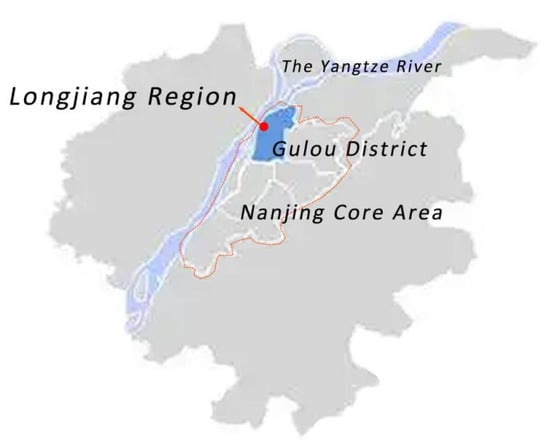
Figure 1.
Location of Longjiang Region, Nanjing, China.
To reduce the interference of redundant factors outside the site, according to the conditions of residence closure degree, residential building form, location and size of the neighborhood, and degree of openness of the activity space, the following criteria were used to select the sample residential neighborhoods: (1) the land use of the public space for children’s activities was only for residence, not for urban green space and squares. (2) Within 500 m walking distance of the neighborhood was basically residential land with no urban or regional business and sports centers, and no commercial personnel or others interfered with children’s activities. (3) There were specific activity sites for local residents in the neighborhood, and the site served at least 500 households. Therefore, this paper selected 15 typical children’s outdoor activity spaces in the Longjiang Region as research objects, with 1–10 being children’s activity spaces in closed residential neighborhoods and 11–15 being children’s activity spaces in open ones. The following are the locations of the sample neighborhoods (Figure 2) and the current situation (Table 1).
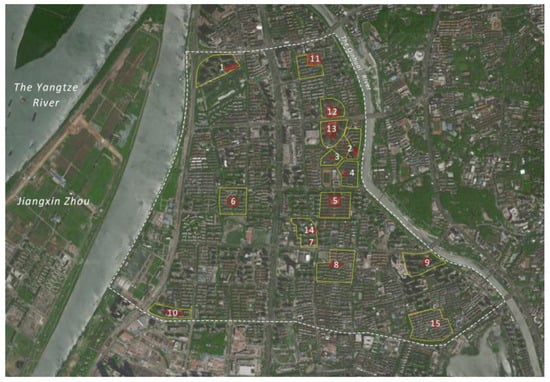
Figure 2.
Locations of sample residential neighborhoods in Longjiang Region.

Table 1.
Pictures of the sample residential neighborhoods.
3.3. Research Contents and Methods
3.3.1. Behaviors of CIAs
The total number of CIAs and the type of independent activities in the sites were counted by methods of observation and behavior mapping. The survey was conducted via the stratified random sampling method, and two representative days of a school day and a weekend day with preferred and comfortable weather were selected to infer the general characteristics of children’s activities by probability. The research team carried out several pre-studies on the sample to learn about a basic understanding of the general situation of children’s activities under different climatic and weather conditions. Since Nanjing is a typical hot summer and cold winter city, the summer (June to August) is excessively hot, with temperatures between 30 °C and 39 °C and the winter temperatures (December to February) are typically between −11 to 2 °C and very humid. These are extremely unsuitable temperatures for outdoor activities and the number of independent activities among children is obviously low compared to the spring and autumn. For these reasons, the observation time were set in October, when the weather was favorable for children’s independent activities. During this time, students had just started a new semester, there was less study pressure, and more children had time to play outdoors. The research results were also meaningful for practice. Fifteen researchers with professional backgrounds conducted simultaneous observations on two sunny days—a weekday and a weekend day, in different sample residential neighborhoods from 9:30–11:30, 13:30–15:30, and 16:00–18:00. Children aged 0–12 years were categorized into preschoolers (0–5 years), lower elementary school children (6–8 years), and upper elementary school children (9–12 years) according to their independence competence. The number of children, independent activities and behaviors were recorded.
3.3.2. Guardians’ Evaluation of CIAs and Residential Outdoor Space Safety
The impact of spatial safety on the neighborhood and children’s permission to engage in independent activities was investigated by a questionnaire. Studies indicated that the most important factors influencing guardians’ decisions on CIAs stem from concerns about the safety of children’s independent activities, which can be summarized as below: (1) concerns about neighborhood safety, including the level of neighborhood harmony and “stranger crisis” [49]; (2) concerns about the dangers of the community environment, including traffic, activity facilities, and activity spaces [50,62]; and (3) confidence and assurance of children’s independent activities [24,44], as evidenced by parents’ prior safety education and indirect supervision of children’s independent activities. However, most of the sample selected in this study were gated residential neighborhoods with strict access control systems and equipped with security booths and other facilities. Parents in the sample neighborhoods who were interviewed as part of the pre-study all acknowledged a high level of satisfaction with the neighborhoods’ harmony and safety, while factors (2) and (3) were more contentious. As a result, variables (2) and (3) were regarded as key considerations to enhance the relevance of the questionnaire. Finally, the questionnaire consisted of four sections: basic demographic information, children’s activity characteristics, safety events, and caregiving styles. Because children were not cognitively or expressively capable of filling out the questionnaire, the parental questionnaire was adopted. The pre-survey found that most of the children played with the elderly or nannies on weekdays, while parents were present for supervision on weekends. In order to ensure a reasonable distribution of age and crowd types of the respondents, the survey included data on a weekday and a weekend day.
3.3.3. Objective Built Environment
Field measurements, software measurements, and qualitative analysis were used to obtain objective built environment data for the sample residential neighborhoods, including indicators at four levels: site, facilities, management, and the residential neighborhood.
3.4. Factors Influencing the Built Environment
Based on the literature review of existing studies, we summarized the relevant residential outdoor activity spatial elements and initially screened out the factors affecting children’s independent activities that appeared more frequently at four levels. Secondly, through field research, the current situation of the existing outdoor activity space in the sample settlements was analyzed, missing factors were added, and 17 influencing factors were finally determined as research variables, among which were eleven figure variables—site area; activity space area; density of entrances and exits; permeability coefficient of site boundary; ratio of tree coverage; ratio of shrub coverage; ratio of soft and hard paving; functional mix degree; density of seats; diversity of activity facilities; population density, and six classified variables—traffic safety; security; sanitation; facility safety; gated residential neighborhood; and building floors (Table 2).

Table 2.
Definition and calculation formula of built environment factors.
4. Research Result
The investigation was conducted on a workday and a weekend day in mid-October 2021, when the weather was favorable for children’s outside activities. The majority of independently active children in the residential outdoor space were 6–12 years old, with the highest number of active children between 9:30–11:30 a.m. and 4:00–6:00 p.m., according to statistical data from 15 samples.
4.1. Characteristics of CIAs
Spatially, the residential outdoor space was the major place for children’s daily activities. The frequency of children’s outdoor activities mainly ranged from 4–7 times per week, and the residential neighborhood was the main place for children’s activities. In terms of duration, 83.79% of children were active more than 3 times per week (4–5 times = 31.08%, 6–7 times = 34.80%, more than 7 times = 17.91%), and 77.03% of children spent more than 30 min per activity (0.5–1 h = 35.81%, 1–2 h = 38.18%, more than 2 h = 3.04%). Outdoor activities were the main way for children to do their daily activities (Table 3).

Table 3.
Statistics on the characteristics of CIAs.
The demand for CIAs is directly proportional to age, with no discernible gender differences. The proportion of independently active children increased with age. 37.18% of active children aged 6–8 have independent activities, and the proportion of independent activities among children aged 9–12 is as high as 62.82%. With regard to gender difference, the independent activity of boys was slightly higher than that of girls, but there was more diversity among the sample settlements, such as 34.88% of girls were independently active in sample 6 and 100% in sample 11. After excluding the highest and lowest particular values, the statistics showed that more boys than girls were independently active in 8 samples, the same percentage of both sexes in 2 samples, and a smaller percentage of independent boys than girls in 3 samples (Table 4).

Table 4.
Statistics on the age and gender differences of CIAs in sample neighborhoods.
Children with independent activities had a wider range of activities than those who were not. The study discovered that independent children prefer path-based sports, such as bicycles, scooters, roller skating, and running, with 51.78% of independent children participating in wheeled sports and 77.78% of them running. The choice of activity type allowed them to move more widely and radiate throughout the site. Children who were not independently active were more likely to engage in activities such as enjoying nature, using activity facilities, playing interactive games, jumping rope, doing exercises, and taking a stroll. Children’s independent activity preferences were observed to vary by gender. Boys preferred energetic activities such as interactive games, ball games, wheeled sports, and running, accounting for 60.67%, 70.71%, 57.92%, and 57.14%, respectively. While independently active girls preferred relatively static activities such as being close to nature, active facilities, jumping rope and doing exercises, walking and chatting, and other less physically demanding activities (Figure 3).
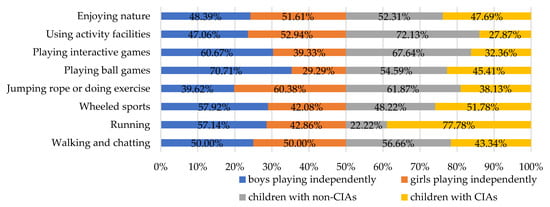
Figure 3.
Gender difference of CIAs and proportion of CIAs and non-CIAs.
4.2. Scenario Analysis of CIAs
Among the 15 sample spaces studied, six of the sample neighborhoods (classified as Type A neighborhoods) had a high proportion of CIAs, all above 40%. In contrast, the other nine sample neighborhoods (classified as Type B neighborhoods) had a proportion of CIAs below 30%. The differences of CIAs between the two types of neighborhoods were obvious. As a way to explore the relationship between the built environment factors of outdoor activities in neighborhoods and CIAs in terms of age, behavior, and range of activities, typical sites for CIAs in Type A neighborhoods were chosen to illustrate scenarios of CIAs in diverse spatial settings (Table 5).

Table 5.
Scenario analysis of CIAs.
4.2.1. Subjects of Independent Activities
The majority of the independent outdoor activities are for children aged 6 to 12, and as they become older, the sort of outdoor activity evolves from low to high intensity. The younger children, around 6–8 years old, were fascinated by the outdoor spaces and mostly immersed in static activities. The activities they enjoyed included viewing plants, picking flowers and plants, collecting twigs and leaves, and playing with activity facilities. The independent activity preferences of 9–12 years old include running, jumping, riding, and other activities that were high-intensity and slightly challenging.
4.2.2. Independent Activity Space
Independent activities for 6–8 years old children were those such as being near nature and using activity facilities. Activity facilities included exclusive play facilities for children and fitness facilities for adults in the neighborhood. The activity space depended upon the neighborhood’s functional space, and all the spaces were soft paving, such as lawn, sand pits, and plastic floors. Children aged 9 to 12 prefer ball sports or wheeled sports, and the space was primarily wide and hard-paved to adapt children to jogging and riding.
4.2.3. Independent Activity Behaviors
Children’s independent activity behaviors are creative, but the ways and types of children’s activities were largely similar in different neighborhood spaces. Independently active children had established special “activity rules” in the outdoor spaces of current neighborhoods. They participated in treasure hunts by digging and picking plants, speed races on slopes and steps, as well as climbing activity facilities to view from the top.
4.2.4. Range of Activity
The range of CIAs expanded with the increase of children’s activity intensity. Nature activities were centered on the landscape and radiated outward in a circle or fan shape. Facility-based activities took the facility site area as the boundary. In the open part of the courtyard, ball games formed an “invisible boundary,” and children played in groups. Cycling activities were provided in the form of curving paths and were not limited to a specific place.
4.3. Built Environment Differences of CIAs
A descriptive analysis of the built environment of Type A and Type B neighborhoods was carried out (Table 6) to investigate the reasons for the differences in the environments of the two types of neighborhoods as well as the reasons for the differences in the proportion of independent activities of children.

Table 6.
Built environment and proportion of CIAs in sample residential neighborhoods.
Site level. The area of the selected 15 sample sites ranged from 322 m2 to 15,960 m2, the activity space area ranged from 145 m2 to 2300 m2, the entrance and exit density ranged from 0.01 to 0.35, the interface permeability coefficient ranged from 0.32 to 0.849, and the shrub coverage ranged from 0.23–52.62%, the ratio of tree coverage ranged from 1.58–53.63%, the ratio of soft and hard paving was between 0–191.78%, and the functional mix degree was between 0–0.81. Among them, the average site area of Type A residential neighborhoods was 3238 m2, the average area of activity space was 721 m2, the density of entrances and exits was 0.06%, and the average functional mix around the site was 0.16, all of which were smaller than that of Type B residential neighborhoods. The average ratio of shrub coverage was 15.85%, the average ratio of tree coverage was 26.95%, and the average ratio of soft and hard paving was 42.7%, all of which were larger than that of Type B. In terms of interface permeability coefficient, the average values of indicators of the two types of residential neighborhoods were basically the same.
In terms of facility level, the density of seats in the sample residential neighborhoods ranged from 0.01% to 0.21% and the diversity of activity facilities ranged from 0 to 0.94. These two indicators in the Type A residential neighborhoods were higher than those in Type B, which were 0.66% and 0.22% higher respectively.
Management level. Residential neighborhoods with walkways around the site accounted for 33% of the total. 40% of the samples were equipped with security patrols. The proportion of samples with clean and well-equipped facilities was 87% and 67% respectively. Among them, Type A residential neighborhoods have stricter control over motor vehicles and better separation of people and vehicles. Furthermore, security, sanitation, and activity equipment maintenance were superior to Type B residential neighborhoods.
Residential neighborhood level. Gated residential neighborhoods made up 67% of the sample. The residential densities ranged from 2.71% to 8.50%, with high-rise neighborhoods accounting for 60% of the samples. Type A residential neighborhoods were all closed residential areas. Furthermore, in terms of building floors, multi-story and high-rise buildings in Type A residential neighborhoods were 17% less prevalent than in Type B residential neighborhoods.
Through a combination of subjective and objective analyses, the following is a more in-depth investigation of the influential relationships between elements of CIAs, the built environment, and guardians’ subjective evaluations in the fifteen samples of residential neighborhoods.
5. Relationship between CIAs and the Environment of Outdoor Activity Space in Residential Neighborhoods
5.1. The Influence of Guardians on CIAs Permissions
A total of 330 questionnaires were collected from the sample residential areas, and 296 valid questionnaires were obtained after sifting through them, with an effective rate of 89.7%. SPSS 21.0 was used to test the reliability and validity of the research questionnaire. The reliability of the questionnaire was expressed by Cronbach’s α-coefficient with a value of 0.821 (>0.8). The validity was tested by the KMO test and Bartlett’s test of sphericity, with a KMO value of 0.812 (>0.6) and a p-value of 0.000 (<0.01), indicating that the reliability and validity of the questionnaire were good and met the demand of statistical analysis.
In this study, the independent variables of the model are “Places where children’s safety incidents occurred” and “Ways to supervise children”. The dependent variable “whether children are allowed to move independently” was coded by 0 and 1, and a binary logistic regression model was used via SPSS21.0 to assess the impact of resident safety and the guardians on children’s independent activity decision (Table 7).

Table 7.
Binary Logistic Regression Analysis of guardians on CIAs permissions.
The finding reveals that waterfront areas in the neighborhood (95% CI 0.299, 1.113; p value = 0.100) and safety incidents at activity sites (95% CI 0.346, 1.091; p value = 0.097) reduced parents’ willingness to allow children to be independently active. Children who accepted safety education (95% CI 2.553, 7.142; p value = 0.000) and took mobile phones or positioning wristbands (95% CI 3.069, 15.71; p value = 0.000) were more likely to be permitted to play independently.
5.2. The Relationship between CIAs and Built Environmental Factors
To further clarify the relationship between CIAs and the built environment, the study took the proportion of children’s independent activities as the dependent variable and the built environment as the independent variable. SPSS 21.0 software was used to conduct a correlation analysis.
First, the numerical variables were tested for normal distribution, which was satisfied when the p-value was more significant than 0.1. Then, the Pearson correlation coefficient was used for the numerical variables that satisfied the normal distribution, and the Spearman correlation coefficient analysis was used for the numerical variables that did not satisfy the normal distribution. The independent sample t-test analysis was applied to the categorical variables, and the correlation coefficients and the significance of each index were finally obtained for the built environment and the proportion of CIAs (Table 8).

Table 8.
Analysis of the correlation between CIAs and the built environment.
At the site level, the ratio of tree coverage had an association with the proportion of CIAs (p value = 0.023), with a correlation coefficient of 0.582. The proportion of soft and hard pavement was positively correlated with the proportion of CIAs (p value = 0.044), with a correlation coefficient of 0.527. A p value of 0.014 and a correlation coefficient of 0.617 showed a negative link between the functional mix of the neighborhood and CIAs. The proportion of CIAs was not significantly correlated with the size of the site, the size of the activity space, the density of entrances and exits, the permeability of the interface, or the shrub coverage.
There was a consistent trend at the facility level between activity facility diversity and the proportion of CIAs (p value = 0.033). The proportion of CIAs was not related to the density of seats.
At the environmental management level, sanitation status (p value = 0.020) was positively correlated with facility safety (p value = 0.013) and the proportion of CIAs, with correlation coefficients of 0.593 and 0.622, respectively. The correlation study found no correlation between traffic safety and security status.
At the residential neighborhood level, gated residential neighborhoods (p value = 0.005) and higher residential population density (p value = 0.030) favored CIAs. The residential building floors do not significantly affect the percentage of CIAs.
6. Discussion
6.1. Opportunities and Characteristics of CIAs
The WHO guidelines on physical activity and sedentary behavior, published in November 2020, stated that children should guarantee 60 min of moderate to vigorous aerobic activity per day, but only 41.22% of the children surveyed satisfied the requirements. This could be due to the fact that Chinese children’s outdoor activities are influenced by their guardians’ decisions, and their activity time is limited to some extent by their parents’ work schedules. The present study is in agreement with the finding that children’s activity hours during weekdays was remarkably shorter than during rest days due to parental availability on weekends [64]. According to interviews with Chinese parents, although social order has improved dramatically and they expressed high support for their children’s physical activity, they remained concerned about safety issues, which are particularly important for guardians. Consistent with some studies in developed countries, parental perceptions of the neighborhood-built environment may act as facilitators or barriers to young children’s play and interactions in their local environment [65]. Parents’ perceptions are an essential factor in children’s activities [66]. Besides, being addicted to electronic devices and affording a school workload may also contributing factors.
Furthermore, backyards in some nations provided plenty of areas for children to actively play to meet CIAs, but in others, such as Australia, smaller blocks and larger houses limit the space for children to play around [67]. In China, there is a comparable issue. Children’s access to a wide range of outdoor activities is constrained by the residential environments in China. Chinese families typically live in apartments instead of houses or villas, and in downtown Nanjing, for instance, the majority of the new residential areas are 18–33 story buildings, where children’s play areas are focused in public gardens inside the neighborhoods and their outdoor walking distance is significantly reduced, especially in high-density neighborhoods with lack of parks and squares around. These reasons limited children’s opportunities for outdoor play. All of the possible factors led to nearly 60% of children taking less than an hour of activity time in the questionnaires. The Trust for Public Land (TPL) of the USA launched the Schoolyards to Playgrounds program, which turned underutilized land resources into high-quality open spaces to alleviate a lack of public space, uneven distribution of urban green space, and inadequate community support for children’s development. TPL has renovated over 200 playgrounds in New York, grading and revitalizing vacant sites by upgrading sports and play facilities, resurfacing, and adding fencing [68]. This has resulted in a number of systematically linked activity spaces that encourage and promote independent activities for children in the neighborhood, as well as positive social responses. As for the limited urban living space in China, the layout of children’s activity space should be coordinated at the community level to enhance spatial and facility accessibility between neighborhoods. It is possible to renovate vacant land and transform it into an open ground for children’s outdoor play, personal growth and social interaction. Inter-neighborhood linkages should be strengthened to promote facility accessibility in order to build a harmonious neighborhood living circle and form a continuous, safe and diversified neighborhood children’s play network.
The following reasons may contribute to the age and gender differences in CIAs. Children naturally engage in independent activity, and as they grow, their self-awareness develops along with their mobility, increasing both their demand and the range of their independent play. Regarding gender, it is generally accepted that boys are physically stronger and possess more definite decision-making capabilities than girls [69]. Parents are therefore more inclined to give boys permission for independent activities at the same age. This was consistent with the finding of association between parental perceptions and independent mobility outcomes among children [70].
Based on the age-differentiated, gender-differentiated, and behaviorally creative characteristics of CIAs, different types of spaces should be created in the design of residential outdoor activity spaces to avoid spatial homogenization and homogeneity. For example, we could distinguish the activity space with different activity intensity and safety level according to age, and divide the cognitive space and game space in separate areas. Moreover, it is possible to combine the interactive space for each age group. And it is also important to distinguish the quiet and safe space for observation and exploration and the exciting or interesting space for adventure activities. Diana Memorial Playground in London, UK is a representative of British adventure playgrounds. It created “intentionally provided hazards” through climbing areas, sandpits and micro-terrain, to encourage children to challenge their physical and mental strength, and to cultivate their imagination and spirit of adventure [71]. This would be a meaningful approach to the design of residential neighborhoods in China. Sufficient square space needs to be reserved in advance to provide focused activities for children, such as ball games. Likewise, the design of the residential outdoor activity area necessitates clear movement zoning such as a continuous and safe bicycle traffic network to allow children to engage in independent activities such as cycling and jogging. In addition, the management of motor vehicles around children’s activity sites are supposed to be strengthened, and “buffer zones” should be set aside around the sites as appropriate to guarantee the safety and accessibility of children’s activity areas.
6.2. Built Environment and CIAs
6.2.1. Site Level
The results showed that tree coverage was positively correlated with the proportion of CIAs. Trees can alter microclimate and help to improve thermal comfort in outdoor environments [72]. Multiple studies on greenery have shown that trees are naturally attractive to people and contribute to active physical activity [73,74]. The same was found to apply to independently active children in our research. Children were fond of being close to nature. With regard to tree coverage, trees usually do not obscure views and allow for good visual penetration of the site interior. Moreover, trees are also beneficial in improving neighborhood aesthetics and perceptions of safety and enhancing social cohesion [75,76]. Parents feel a natural affinity for such an environment and are more likely to allow for CIAs. For the analysis of the shrub coverage indicators, it was set based on security and visibility. Good sight penetration supports crowd surveillance [77] and a good shrub management can also improve regional image [78]. This can help to increase regional security and create a favorable environment for CIAs. Specifically, if the shrub covers below 1.5 m are large, children of short height may not be perceived by other people in the site when they play independently, and there is a risk of injury. The study put forth the hypothesis that shrubs below 1.5 m would lessen sight penetration and site safety resulting in poor CIAs. However, the correlation analysis did not reveal any relationship between shrub cover and CIAs. This might be because visibility was unaffected by the shrubs since they were largely at the edge of the sample activity sites. Moreover, interviews revealed that most site users did not noticeably perceive the interface permeability coefficient and shrub cover. The above reasons might account for the lack of significant correlation in this metric. However, at the site design level, greenery is still an important site design indicator. In addition to the aesthetic and experiential qualities that come with greenery, guidelines for the Construction of Child- Friendly Communities in Shenzhen, China, suggests that trees with tall canopies can be placed in the site to meet shade needs, and shrubs below 0.8 m can be placed at the boundary of the site to divide the area and isolate the role of motor vehicles [79]. Some greenery can also be used to prevent mosquitoes and repel insects. Above all, the openness of trees and the enclosing nature of shrubs play an important role in ensuring the safety of children’s activities.
Contrary to expectations, the high functional mix around the activity site is not conducive to CIAs. This indicator was based on existing research on children’s activity preferences, some of which showed a positive correlation between functional mixing and children’s physical activity [25,26]. The analysis of the built environment of the study sample revealed the following possible reasons for such results. In neighborhoods with only function for residence, the population tends to be homogeneous and fixed. Guardians and children may gradually relax vigilance in such an environment. Conversely, some of the activity sites are surrounded by kindergartens, community centers, property centers, kiosks, and courier points. The diverse functions were often accompanied by a complex crowd, such as parents who took their children to and from school, commercial shoppers, and office workers of community centers. The various identities of people moving around the sites raised parents’ concerns about children’s safety, which in turn led to a decrease in the proportion of CIAs.
6.2.2. Facility Level
The findings also indicated that CIAs are promoted by a variety of activity facilities, which enriched different kinds of activities available to children and stimulated interest in and motivation for the activities. Furthermore, a wide variety of activity facilities can satisfy the diverse requirements of the residents, attracting people of all ages and thereby raising the possibility of resident surveillance responsibilities, which in turn lowers the sense of risk to users and promotes CIAs. To that end, the kind and number of facilities should be evaluated concerning the condition of different neighborhoods, and recreational facilities and leisure facilities are supposed to be paid attention to in terms of quality, materials, signage, colors, and so on.
Additionally, it was discovered during the interviews that the barrier-free facilities of the activity site could improve the accessibility of younger children and the safety of activities in the site, as well as exercise the possibility of their independent activities, given that the majority of outdoor activities for infants and toddlers would be assisted by strollers and three-wheeled bicycles. For facility maintenance, the neighborhood should build a long-term facility supervision and maintenance mechanism, encourage parents and children to engage in the collaborative construction and governance of activity spaces, and create appropriate sites for children to relax and recreate. Based on the characteristics of CIAs for different age groups, it is preferable to build a more precise index system of community facilities for children along with the allocation of diverse facilities. It’s also vital to consider about how to support and provide age-mixed and dynamic community facilities and space configurations.
The open space, sports & recreation strategy developed by Wokingham Borough Council in the UK set out the standards and minimum size of facilities for children’s activities in residential communities, such as a minimum of 100 m2 of neighborhood-scale children’s activity space. The council also introduced play space design guide, which suggests different play typologies of open space proposed for all kinds of groups of children on this basis. Particularly it addresses the inclusive play space that will allow children, young people and adults of all ages to interact together and with their environment—a place where a diverse range of users can play in a variety of ways and learn from one another [80]. Shanghai Dinghai Community has achieved a social climate of the intergenerational integration, through dynamic and exploratory facilities and spaces such as the “Community Garden Renovation”, “Stray Cat House” and “Secondhand Bookstore”. Such a strategy promotes children’s independent exploration and communication, which aids in the development of their social and self-care competencies.
6.2.3. Management Level
The study also found that users’ perceptions of the environment largely influenced their behavioral activities and that guardians’ perceptions of the safety of outdoor spaces influenced their decisions about children’s independent activities. At the management level, sanitation and facility safety can affect CIAs. It is recommended that activity sites are supposed to be built in residential areas with clear sightlines and more sight-reachable places based on parents’ and children’s perceptions of environmental safety. Furthermore, we can improve monitoring and management by placing security booths around activity sites, configuring the camera, and assigning security guards to patrol and maintain site sanitation. These can improve guardians’ sense of security for children’s outdoor spaces and promote CIAs by increasing “residential awareness”. In terms of facility maintenance, we propose a long-term facility supervision and maintenance mechanism, which can encourage parents and children to participate in the joint construction and governance of activity places in order to create places that cater to children’s demands for rest and play. Practice in Changsha, China, has shown that establishing children’s councils and involving parents and children in neighborhood planning, implementation, and construction could well improve their understanding and trust in the social environment and increase their sense of “ownership” of the environment. This prototype of resident-led shared management is critical for increasing parents’ and children’s sense of environmental security and promoting parents’ permission for CIAs.
6.2.4. Residential Neighborhood Level
The study showed that the closeness of the neighborhood had a positive effect on CIAs, which was in line with the findings in Western countries that lower street connectivity increased the likelihood of children being active [81]. Street closure interventions might be effective in increasing children’s physical activity [38]. Children did seem to be more independent in their activities when living in a relatively enclosed residential environment, which would increase parents’ and children’s safety perception. Likewise, studies conducted at larger community scales have revealed a connection between children’s outdoor activity and traffic safety, with the presence of crosswalks or traffic lights being positively correlated with outdoor play [82]. Nevertheless, we discovered that the sidewalk outside the site had no discernible impact on the CIAs at a smaller neighborhood scale. This might be a difference due to the size of the traffic volume, and even though the children’s activity site was close to a driveway, the frequency of vehicle presence was much smaller compared to urban roads, potentially negating the traffic effect. Therefore, in the practice of community design, it is necessary to improves continuous paths and expand the exploration space for children that can be safely accessible in the closed neighborhood. Organic linkage of residential inter-building activity space, neighborhood outdoor activity space, supporting services, and walking paths is highly recommended to establish a children’s slow walking system. Chengdu Cuqiao subdistrict of China, for example, established a children’s slow passage with cartoon elements, as well as slow signs and speed bumps at children’s crossing entrances to string together children’s activity facilities in the community in order to protect children’s traffic rights and created safe activity paths. Traffic order optimization can improve the quality and safety of children’s activity spaces, thereby improving CIAs.
A previous study on youth in Nanjing found a consistent and graduated association between residential density and physical activity, those living in higher-density areas being less physically active [83]. As for children, our study found that neighborhoods with higher residential densities tend to incentivize independent activities among children. It is possible that in a more densely populated neighborhood, there are more active people engaging in daily outdoor activities. A relatively fixed population is conducive to the establishment of “familiar neighborhoods” and the promotion of harmony and friendliness, where parents are more comfortable with children being alone in the neighborhood. Neighborhoods of higher residential densities may have more school-age children and they will have more playmates, which may also contribute to the increase in CIAs. In addition, it has been shown that users’ perceptions of environmental safety largely influence their behavioral activities. More soft paving, good sanitation, secure activity facilities, and strict access control can enhance occupants’ psychological comfort and sense of security, build trust in the outdoor activity space and reduce the sense of stranger crisis [84].
Site area, activity space area, and density of seats may influence children’s behavior but have less impact on the proportion of CIAs. Due to the centralized layout of activity spaces inside Chinese neighborhoods, and the clear domain boundaries between residential blocks, it is rare for children within a neighborhood to play alone in another one. When the possibility of self-selection of play space was reduced, the site area, activity space area, and seating density appeared to become “unselectable variables”, and the study failed to investigate the significant correlation between these indicators and CIAs in the 15 samples. Perhaps in more open spaces or urban public spaces, these variables would have an impact. The survey also discovered that children with independent ability are very familiar with elevator use. The time consumed for children living in high-rise and multi-story residential areas travelling to the activity space is both typically less than 5 min, and the convenience is not much different. As a result, the link between building floors and CIAs was tenuous.
6.3. Limitations
The number of samples was modest because it only included the residential parts of Longjiang Region in Nanjing, which may have constrained the findings of the analysis. Additionally, objective data were obtained from on-site observations, and the study only collected information on children playing in the fall. However, children’s activities may vary depending on the weather or other environmental factors. Whenever possible, the characteristics of children’s activities in each season and under different weather conditions should be fully considered to further clarify the characteristics of CIAs under different climatic and weather conditions and their relevance to the built environment of the neighborhood. The interview-based questionnaire is relatively subjective. Although some parents consulted with their children, there might still be cases where the children’s real thoughts were ignored.
Future studies are expected to broaden the coverage of the sample and increase the number of observation periods for CIAs. Children’s discussion groups could also be supplemented to acquire more perspectives. These would help to increase the accuracy and generalization.
7. Conclusions
This paper discussed the issue in the context of the construction of child-friendly cities. The relationship between objective built environment factors and CIAs was empirically analyzed and explored in residential neighborhoods, and it was beneficial to fill up relative gaps in previous research on CIAs at the residential neighborhood level in China. With regard to the current neighborhood construction in China, the pattern of enclosed and managed residential neighborhoods with clear neighborhood boundaries and certain open spaces for children’s activities has led to a tendency for CIAs to be concentrated in the internal areas of neighborhoods. Children’s behavior mapping and questionnaires revealed that CIAs are required by children of all ages. CIAs are also characterized by creativity in behavior and excitement in games. Overall, the study discovered that the built environment factors in the samples had a strong influence on CIAs, including tree coverage, functional mix degree, facility safety, gated neighborhoods and population density. In addition, we also found that factors affecting CIAs were not entirely consistent with those promoting physical activity. Besides, parents’ perception of the safe neighborhood built environment was especially crucial for CIAs. Parents have expressed great concern about the waterfront areas in their neighborhoods, so children’s activity areas should be kept as far away from the waterside as possible, and protection measures for the dikes should be strengthened.
From our study, we could realize that the built environment factors in residential neighborhoods affect CIAs in different forms. It is essential to stimulate children’s motivation toward vigorous activities in order to encourage them to participate in more physical activities, whereas rather more importantly for promoting CIAs is the enhancement of residents’ perceptions of the safety of the residential children’s activity space. The indicators of satisfying tree coverage, a neat and sanitary neighborhood environment, and a higher proportion of soft paving increased the likelihood of CIAs through visual perception. Some indicators, on the other hand, might have an indirect impact on CIAs, such as a lower functional mix and much more enclosed residences, which would limit crowd mobility and reduce site disturbance by unrelated people. In addition, densely populated residential areas promoted CIAs by increasing users’ perception of site safety through “Street eye” or by raising “neighborhood awareness”. In conclusion, we should raise awareness about the provision for children’s activity sites in neighborhoods, as well as make appropriate improvements to the built environment in light of the primary demand of parents or children, in order to improve the comfort, safety, and durability of the sites and thus promote CIAs. Local government departments should exert their roles to explore a more systematic and precise policy system, as well as construction guidelines that meet the needs of local residents with regard to the features of urban development and community types, in order to provide a suitable reference for the construction of child-friendly cities.
The method and result of this study have practical implications for identifying the characteristics of CIAs and exploring the factors influencing CIAs at the residential neighborhood level in China. Future research needs more observation time and wider or more precise classifications of factors, such as the impact of residential neighborhoods in different regions and seasonal changes on CIAs. This research will provide practical child-friendly adaptations to existing neighborhoods and design recommendations for future planning to improve CIAs and promote the health and well-being development of young children.
Author Contributions
Conceptualization, Y.Z., M.W. and S.L.; methodology, M.W. and S.L.; software, M.W. and S.L.; validation, M.W., S.L. and Y.Z.; formal analysis, M.W.; investigation, M.W. and S.L.; data curation, M.W.; writing—original draft preparation, S.L. and M.W.; writing—review and editing, Y.Z., S.L., M.W. and C.Q.; visualization, M.W.; supervision, Y.Z. and C.Q.; project administration, Y.Z.; funding acquisition, Y.Z. and M.W. All authors have read and agreed to the published version of the manuscript.
Funding
This research was funded by Youth Fund of Humanities and social sciences research project of Ministry of Education of China (Grant No. 21YJCZH248), Natural Science Foundation of Jiangsu Province (Grant No. BK20221316), Postgraduate Research & Practice Innovation Program of Jiangsu Province (Grant No. KYCX22_1265), and the general Project of Philosophy and Social Science Research in Colleges and Universities in Jiangsu Province (Grant No. 2021SJA0223).
Institutional Review Board Statement
Not applicable.
Informed Consent Statement
Informed consent was obtained from all subjects involved in the study.
Data Availability Statement
The data are not publicly available due to privacy and security concerns.
Conflicts of Interest
The authors declare no conflict of interest.
References
- Hillman, M.; Adams, J.G.; Whitelegg, J. One False Move. In A Study of Children’s Independent Mobility; Policy Studies Institute: London, UK, 1990. [Google Scholar]
- Kyttä, M. The extent of children’s independent mobility and the number of actualized affordances as criteria for child-friendly environments. J. Environ. Psychol. 2004, 24, 179–198. [Google Scholar] [CrossRef]
- United Nations Children’s Fund. What Is the Child Friendly Cities Initiative? Available online: https://childfriendlycities.org/what-is-the-child-friendly-cities-initiative/ (accessed on 27 May 2022).
- Schoeppe, S.; Duncan, M.J.; Badland, H.; Oliver, M.; Curtis, C. Associations of children’s independent mobility and active travel with physical activity, sedentary Behavior and weight status: A systematic review. J. Sci. Med. Sport 2013, 16, 312–319. [Google Scholar] [CrossRef] [PubMed]
- Mackett, R.; Brown, B.; Gong, Y.; Kitazawa, K.; Paskins, J. Children’s Independent Movement in the Local Environment. Built Environ. 2007, 33, 454–468. [Google Scholar] [CrossRef]
- Murray, L.; Mand, K. Travelling near and far: Placing children’s mobile emotions. Emot. Space Soc. 2013, 9, 72–79. [Google Scholar] [CrossRef]
- Zwerts, E.; Allaert, G.; Janssens, D.; Wets, G.; Witlox, F. How children view their travel Behavior: A case study from Flanders (Belgium). J. Transp. Geogr. 2009, 18, 702–710. [Google Scholar] [CrossRef] [Green Version]
- Tang, Y. Exploration on cultivating children’s independence in game activities. Sci. Chin. 2016, 21, 165. [Google Scholar]
- Prezza, M. Children’s Independent Mobility: A Review of Recent Italian Literature. Child. Youth Environ. 2007, 17, 293–318. [Google Scholar]
- Quarmby, T.; Dagkas, S. Locating the place and meaning of physical activity in the lives of young people from low-income, lone-parent families. Phys. Educ. Sport Pedagog. 2013, 18, 459–474. [Google Scholar] [CrossRef]
- Léa, R.; Aatiqa, J.; Ron, B.; Guy, F. Voices from the survey margins: Investigating unsolicited comments written in children’s activity-travel diaries. Travel Behav. Soc. 2019, 16, 70–76. [Google Scholar]
- Den Besten, O. Local belonging and ‘geographies of emotions’: Immigrant children’s experience of their neighbourhoods in Paris and Berlin. Childhood 2010, 17, 181–195. [Google Scholar] [CrossRef]
- Babb, C.; Olaru, D.; Curtis, C.; Robertson, D. Children’s active travel, local activity spaces and wellbeing: A case study in Perth, WA. Travel Behav. Soc. 2017, 9, 81–94. [Google Scholar] [CrossRef]
- Mikkelsen, M.R.; Christensen, P. Is Children’s Independent Mobility Really Independent? A Study of Children’s Mobility Combining Ethnography and GPS/Mobile Phone Technologies1. Mobilities 2009, 4, 37–58. [Google Scholar] [CrossRef]
- Janet, E.L.; Jason, A.G. Free Range Kids? Using GPS-Derived Activity Spaces to Examine Children’s Neighborhood Activity and Mobility. Environ. Behav. 2016, 48, 421–453. [Google Scholar]
- Alison, C.; Ben, W.; Ben, S.; Mayer, H. A comparison study of children’s independent mobility in England and Australia. Child. Geogr. 2013, 11, 461–475. [Google Scholar]
- Buliung, R.N.; Larsen, K.; Faulkner, G.; Ross, T. Children’s independent mobility in the City of Toronto, Canada. Travel Behav. Soc. 2017, 9, 58–69. [Google Scholar] [CrossRef]
- Scheiner, J.; Huber, O.; Lohmüller, S. Children’s independent travel to and from primary school: Evidence from a suburban town in Germany. Transp. Res. Part A Policy Pract. 2019, 120, 116–131. [Google Scholar] [CrossRef]
- Broberg, A.; Salminen, S.; Kyttä, M. Physical environmental characteristics promoting independent and active transport to children’s meaningful places. Appl. Geogr. 2013, 38, 43–52. [Google Scholar] [CrossRef]
- Zougheibe, R.; Xia, J.C.; Dewan, A.; Gudes, O.; Norman, R. Children’s outdoor active mobility Behavior and neighbourhood safety: A systematic review in measurement methods and future research directions. Int. J. Health Geogr. 2021, 20, 2. [Google Scholar] [CrossRef]
- Zougheibe, R.; Jepson, B.; Norman, R.; Gudes, O.; Dewan, A. Is there a correlation between children’s outdoor active mobility Behavior and neighbourhood safety? A systematic review of the evidence. BMJ Open 2021, 11, e047062. [Google Scholar] [CrossRef]
- Davison, K.; Lawson, C.T. Do Attributes in the Physical Environment Influence Children’s Physical Activity? A Review of the Literature. Int. J. Behav. Nutr. Phys. Act. 2006, 3, 19. [Google Scholar] [CrossRef] [Green Version]
- Page, A.S.; Cooper, A.R.; Griew, P.; Davis, L.; Hillsdon, M. Independent mobility in relation to weekday and weekend physical activity in children aged 10–11 years: The PEACH Project. Int. J. Behav. Nutr. Phys. Act. 2009, 6, 2. [Google Scholar] [CrossRef] [Green Version]
- Dodd, H.F.; FitzGibbon, L.; Watson, B.E.; Nesbit, R.J. Children’s Play and Independent Mobility in 2020: Results from the British Children’s Play Survey. Int. J. Environ. Res. Public Health 2021, 18, 4334. [Google Scholar] [CrossRef]
- Riazi, N.A.; Blanchette, S.; Trudeau, F.; Larouche, R.; Tremblay, M.S.; Faulkner, G. Correlates of Children’s Independent Mobility in Canada: A Multi-Site Study. Int. J. Environ. Res. Public Health 2019, 16, 2862. [Google Scholar] [CrossRef] [Green Version]
- Ikeda, E.; Hinckson, E.; Witten, K.; Smith, M. Associations of children’s active school travel with perceptions of the physical environment and characteristics of the social environment: A systematic review. Health Place 2018, 54, 118–131. [Google Scholar] [CrossRef]
- Mitchell, C.; Clark, A.; Gilliland, J. Built Environment Influences of Children’s Physical Activity: Examining Differences by Neighbourhood Size and Sex. Int. J. Environ. Res. Public Health 2016, 13, 130. [Google Scholar] [CrossRef]
- Guo, X.; Dai, J.; Xun, P.; Jamieson, L.M.; He, K. Sport facility proximity and physical activity: Results from the Study of Community Sports in China. Eur. J. Sport Sci. 2015, 15, 663–669. [Google Scholar] [CrossRef]
- Wong, B.Y.; Ho, S.; Lo, W.; Cerin, E.; Mak, K.; Lam, T. Longitudinal relations of perceived availability of neighborhood sport facilities with physical activity in adolescents: An analysis of potential moderators. J. Phys. Act. Health 2014, 11, 581–587. [Google Scholar] [CrossRef]
- Sharmin, S.; Kamruzzaman, M. Association between the built environment and children’s independent mobility: A meta-analytic review. J. Transp. Geogr. 2017, 61, 104–117. [Google Scholar] [CrossRef]
- Leung, K.Y.K.; Loo, B.P.Y. Association of children’s mobility and wellbeing: A case study in Hong Kong. Travel Behav. Soc. 2017, 9, 95–104. [Google Scholar] [CrossRef]
- Michelle, M.R.F.E. Do parental perceptions of the neighbourhood environment influence children’s independent mobility? Evidence from Toronto, Canada. Urban Stud. 2014, 16, 3401–3419. [Google Scholar]
- Mammen, G.; Faulkner, G.; Buliung, R.; Lay, J. Understanding the drive to escort: A cross-sectional analysis examining parental attitudes towards children’s school travel and independent mobility. BMC Public Health 2012, 12, 862. [Google Scholar] [CrossRef] [PubMed] [Green Version]
- Fyhri, A.; Hjorthol, R.; Mackett, R.L.; Fotel, T.N.; Kyttä, M. Children’s active travel and independent mobility in four countries: Development, social contributing trends and measures. Transp. Policy 2011, 18, 703–710. [Google Scholar] [CrossRef] [Green Version]
- Ward, J.S.; Duncan, J.S.; Jarden, A.; Stewart, T. The impact of children’s exposure to greenspace on physical activity, cognitive development, emotional wellbeing, and ability to appraise risk. Health Place 2016, 40, 44–50. [Google Scholar] [CrossRef] [PubMed]
- Lambert, A.; Vlaar, J.; Herrington, S.; Brussoni, M. What Is the Relationship between the Neighbourhood Built Environment and Time Spent in Outdoor Play? A Systematic Review. Int. J. Environ. Res. Public Health 2019, 16, 3840. [Google Scholar] [CrossRef] [Green Version]
- Billie, G.; Gina, W.; Terri, P.; Vincent, L.; Max, B.; Kimberly, V.N.; Anna, T.; Gavin, M.; Karen, V. School site and the potential to walk to school: The impact of street connectivity and traffic exposure in school neighborhoods. Health Place 2011, 17, 545–550. [Google Scholar]
- Holt, N.L.; Spence, J.C.; Sehn, Z.L.; Cutumisu, N. Neighborhood and developmental differences in children’s perceptions of opportunities for play and physical activity. Health Place 2008, 14, 2–14. [Google Scholar] [CrossRef]
- Kenney, M.K. Child, family, and neighborhood associations with parent and peer interactive play during early childhood. Matern. Child Health J. 2012, 16 (Suppl. S1), 88–101. [Google Scholar] [CrossRef]
- Cordovil, R.; Lopes, F.; Neto, C. Children’s (in)dependent mobility in Portugal. J. Sci. Med. Sport 2015, 18, 299–303. [Google Scholar] [CrossRef]
- Lam, W.L.B. Determinants of Children’ s Independent Mobility in Hong Kong. Asian Transp. Stud. 2014, 3, 250–268. [Google Scholar]
- Karen, V.; Billie, G.; Max, B.; Georgina, T.; Anna, T.; Gavin, M.; Kimberly, V.N. Does the walkability of neighbourhoods affect children’s independent mobility, independent of parental, socio-cultural and individual factors? Child. Geogr. 2014, 12, 393–411. [Google Scholar] [CrossRef]
- Christian, H.E.; Klinker, C.D.; Villanueva, K.; Knuiman, M.W.; Foster, S.A.; Zubrick, S.R.; Divitini, M.; Wood, L.; Giles-Corti, B. The Effect of the Social and Physical Environment on Children’s Independent Mobility to Neighborhood Destinations. J. Phys. Act. Health 2015, 12, S84–S93. [Google Scholar] [CrossRef] [Green Version]
- Riazi, N.A.; Brussoni, M.; Vertinsky, P.; Faulkner, G. “Well, You Feel More Responsible When You’re Unsupervised”: Exploring Family Perspectives on Children’s Independent Mobility. Children 2021, 8, 225. [Google Scholar] [CrossRef]
- Boxberger, K.; Reimers, A. Parental Correlates of Outdoor Play in Boys and Girls Aged 0 to 12—A Systematic Review. Int. J. Environ. Res. Public Health 2019, 16, 190. [Google Scholar] [CrossRef] [Green Version]
- Al-Mosaind, M. The effect of age & gender on children’s mobility in Riyadh’s neighborhoods. Heliyon 2019, 5, e1327. [Google Scholar] [CrossRef] [Green Version]
- Bagheri, H.; Zarghami, E. Assessing the effects of Children’s independent mobility range and time. J. Transp. Health 2020, 19, 100960. [Google Scholar] [CrossRef]
- Carver, A.; Panter, J.R.; Jones, A.P.; van Sluijs, E.M.F. Independent mobility on the journey to school: A joint cross-sectional and prospective exploration of social and physical environmental influences. J. Transp. Health 2014, 1, 25–32. [Google Scholar] [CrossRef]
- Marzi, I.; Demetriou, Y.; Reimers, A.K. Social and physical environmental correlates of independent mobility in children: A systematic review taking sex/gender differences into account. Int. J. Health Geogr. 2018, 17, 24. [Google Scholar] [CrossRef] [Green Version]
- Veitch, J.; Carver, A.; Salmon, J.; Abbott, G.; Ball, K.; Crawford, D.; Cleland, V.; Timperio, A. What predicts children’s active transport and independent mobility in disadvantaged neighborhoods? Health Place 2017, 44, 103–109. [Google Scholar] [CrossRef]
- Ferrao, T.; Janssen, I. Parental encouragement is positively associated with outdoor active play outside of school hours among 7–12 year olds. Peerj 2015, 3, e1463. [Google Scholar] [CrossRef]
- Veitch, J.; Bagley, S.; Ball, K.; Salmon, J. Where do children usually play? A qualitative study of parents’ perceptions of influences on children’s active free-play. Health Place 2006, 12, 383–393. [Google Scholar] [CrossRef] [Green Version]
- Emma, L.J.E.; Michael, J.D.; Samantha, L.B.; Val, C. Environmental and school influences on physical activity in South Asian children from low socio-economic backgrounds. J. Child Health Care 2015, 19, 345–358. [Google Scholar]
- Benjamin, E.; Leah, M.B. Neighborhood influences on young children’s conduct problems and pro-social behavior: Evidence from an Australian national sample. Child. Youth Serv. Rev. 2008, 31, 317–324. [Google Scholar]
- Tong, C. A study on Community Street Space Based on Children’s Independent Mobility Charactieristics. Master’s Thesis, Hunan University, Changsha, China, 2018. [Google Scholar]
- Hu, X. Study on Characteristics and Environmental Support System of Children’s Independent Mobility in Hong Li Community od Shenzhen. Master’s Thesis, Harbin Institute of Technology, Harbin, China, 2018. [Google Scholar]
- Wang, T. Study on the Environmental Optimization of Primary School Students’ Independent Schooling from the Perspective of Urban Renewal—A Case Study of the Western District of Hohhot. Master’s Thesis, Inner Mongolia University of Technology, Hohhot, China, 2020. [Google Scholar]
- Yao, S.; Zhu, H.; Shi, Y.; Ye, Q. Study on the Influencing Factors and Planning Strategies of Urban Built Environment on Children’s Independent Mobility. Urban Plan. Int. 2021, 36, 17–23. [Google Scholar]
- Zhang, S.J.; Li, J.W.; Hong, L.F.; Liang, X.; Huang, C.H. Research on outdoor playgrounds for children in settlements: A case study of Guilin. J. Guilin Univ. Technol. 2018, 38, 269–275. [Google Scholar]
- Lin, C.W.; Han, X.L.; Fan, J. Impacts of land development intensity on children’s outdoor physical activities: A case study of Shenzhen. City Plan. Rev. 2018, 42, 97–102. [Google Scholar]
- Xiao, X.L.; Han, X.L. Spatial Characteristics and impacting factors of children’s outdoor physical activities in urban village neighborhood: A case study of Pingshan neighborhood in Shenzhen. Mod. Urban Res. 2019, 1, 8–14. [Google Scholar]
- Lopes, F.; Cordovil, R.; Neto, C. Independent Mobility and Social Affordances of Places for Urban Neighborhoods: A Youth-Friendly Perspective. Front. Psychol. 2018, 9, 2198. [Google Scholar] [CrossRef]
- Offwell Woodl and Wildlife Trust. Simpson’s Diversity Index. Available online: http://www.countrysideinfo.co.uk/simpsons.htm (accessed on 25 May 2022).
- Meng, X.; Li, L.L.; Fu, B.C. Study on the optimization design of neighborhood-built environment based on an investigation of primary-school-age children’s outdoor leisure activities. Archit. J. 2020, S2, 164–170. [Google Scholar]
- Robinson, T.; Nathan, A.; Murray, K.; Christian, H. Parents’ perceptions of the neighborhood-built environment are associated with the social and emotional development of young children. J. Environ. Res. Public Health 2022, 19, 6476. [Google Scholar] [CrossRef]
- Allender, S.; Cowburn, G.; Foster, C. Understanding participation in sport and physical activity among children and adults: A review of qualitative studies. Health Educ. Res. 2006, 21, 826–835. [Google Scholar] [CrossRef] [Green Version]
- Morgan, E. The life and death of the Australian backyard (Tony Hall). Urban Geogr. 2014, 35, 629–630. [Google Scholar] [CrossRef]
- Best Practice: Converting Schoolyards to Community Playgrounds. Available online: http://www.nyc.gov/html/ia/gprb/downloads/pdf/NYC_Parks&Rec_Schoolyards.pdf (accessed on 6 August 2022).
- Zhang, Z. Analysis of physical activity levels and influencing factors of children and adolescents in Nanjing. Chin. J. Sch. Health 2018, 39, 1885–1888. [Google Scholar] [CrossRef]
- Wolfe, M.K.; McDonald, N.C. Association Between Neighborhood Social Environment and Children’s Independent Mobility. J. Phys. Act. Health 2016, 13, 970–979. [Google Scholar] [CrossRef] [PubMed]
- Diana Memorial Playground. Available online: https://www.royalparks.org.uk/parks/kensington-gardens/things-to-see-and-do/diana-memorial-playground (accessed on 6 August 2022).
- Loyde, V.D.A.; Lucila, C.L.; Andreas, M. Effect of tree planting design and tree species on human thermal comfort in the tropics. Landsc. Urban Plan 2015, 138, 99–109. [Google Scholar]
- Yi, L.; Chinmoy, S.; Yang, X. The effect of street-level greenery on walking behavior: Evidence from Hong Kong. Soc. Sci. Med. 2018, 208, 41–49. [Google Scholar]
- Guillem, V.; Oriol, M.; Carme, M. Green streetscape and walking: Exploring active mobility patterns in dense and compact cities. J. Transp. Health 2019, 12, 50–59. [Google Scholar]
- Tsai, W.-L.; Yngve, L.; Zhou, Y.; Beyer, K.M.; Bersch, A.; Malecki, K.M.; Jackson, L.E. Street-level neighborhood greenery linked to active transportation: A case study in Milwaukee and Green Bay, WI, USA. Landsc. Urban Plan 2019, 191, 103619. [Google Scholar] [CrossRef]
- Hartig, T.; Mitchell, R.; de Vries, S.; Frumkin, H. Nature and health. Annu. Rev. Public Health 2014, 35, 207–228. [Google Scholar] [CrossRef] [Green Version]
- Robertson, J.M. PLAYGROUND SAFETY: Differences Between Public & Residential Playgrounds. Prof. Saf. 2020, 65, 46. [Google Scholar]
- Cho, M.; Park, C.; Jang, J. The Effects of Urban Park and Vegetation on Crime in Seoul and Its Planning Implication to CPTED. J. Korean Inst. Landsc. Archit. 2018, 46, 27–35. [Google Scholar] [CrossRef] [Green Version]
- Guideline for the Construction of Child-Friendly Communities in Shenzhen. Available online: http://www.szfegw.cn/attachment/0/6/6301/105049.pdf (accessed on 6 August 2022).
- Play Space Design Guide. Available online: https://www.wokingham.gov.uk/_resources/assets/attachment/full/0/462172.pdf (accessed on 6 August 2022).
- Tappe, K.A.; Glanz, K.; Sallis, J.F.; Zhou, C.; Saelens, B.E. Children’s physical activity and parents’ perception of the neighborhood environment: Neighborhood impact on kids study. Int. J. Behav. Nutr. Phys. Act. 2013, 10, 39. [Google Scholar] [CrossRef] [Green Version]
- Carver, A.; Timperio, A.; Crawford, D. Playing it safe: The influence of neighbourhood safety on children’s physical activity. A review. Health Place 2008, 14, 118–131. [Google Scholar] [CrossRef]
- Xu, F.; Li, J.; Liang, Y.; Wang, Z.; Hong, X.; Ware, R.S.; Leslie, E.; Sugiyama, T.; Owen, N. Associations of residential density with adolescents’ physical activity in a rapidly urbanizing area of mainland China. J. Urban Health 2010, 87, 44–53. [Google Scholar] [CrossRef]
- Zhong, L.; Gong, P.; Gu, X.R. Urban open space research review based on children’s safety. Urban Plan. Int. 2016, 31, 76–82. [Google Scholar]
Publisher’s Note: MDPI stays neutral with regard to jurisdictional claims in published maps and institutional affiliations. |
© 2022 by the authors. Licensee MDPI, Basel, Switzerland. This article is an open access article distributed under the terms and conditions of the Creative Commons Attribution (CC BY) license (https://creativecommons.org/licenses/by/4.0/).
